Movie Review By: SFAM
Year: 2002
Directed by: Steven Spielberg
Written by: Philip K. Dick (short story), Scott Frank & Jon Cohen (screenplay)
IMDB Reference
Degree of Cyberpunk Visuals: High
Correlation to Cyberpunk Themes: Medium
Key Cast Members:
Chief John Anderton: Tom Cruise
Pre-Crime Director Lamar Burgess: Max von Sydow
Agatha: Samantha Morton
Danny Witwer: Collin Ferrel
Evanna (John’s Wife): Jessica Capshaw
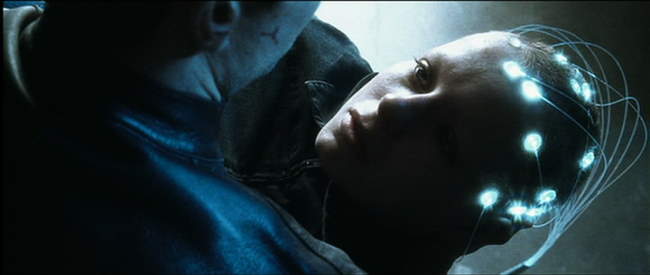
Overview: Minority Report, directed by Steven Spielberg, is another one of the large scale production cyberpunk movies that cleared a hefty gross (358 million worldwide, not counting DVD sales). Minority Report works both as a summer blockbuster (it was released in June), but also as a fairly intelligent cyberpunk flick. Based on another terrific story from Phillip K. Dick, Minority Report has a terrific cast headed up by Tom Cruise and Max Von Sydow, awesome special effects, and terrific music and sound FX throughout.
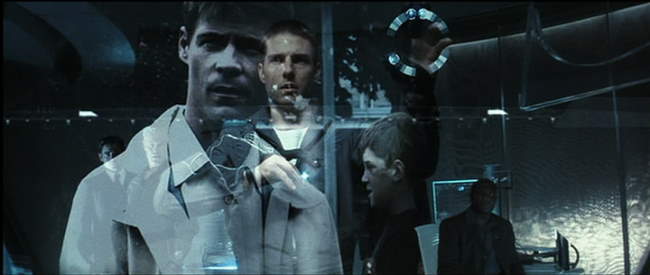
The Story: In Minority Report, Tom Cruise stars as John Anderton, a police chief at the head of an elite pilot police program, now in its sixth year, that prevents crimes BEFORE they are committed. The year is 2054, and the ability now exists within gifted, but altered people called “precogs” to tell when someone is about to commit a crime. The Precogs, comprised of two twins and one woman, Agatha (played wonderfully by Samantha Morton), are kept at all times in a dreamlike state in strange pool of water. The Precogs receive visions of murders that will be taking place. Based on an elaborate system that works off the Precogs, the police are able to extract the visions and are given the names of the murder victim and the murderer on color coded balls. Based on this, all premeditated murders have become a thing of the past – now the only murders that “might” take place are the crimes of passion, or “red balls” in Minority Report terms. When a red ball comes, the John Anderton must quickly work with the dreams to find the location of the murder (which often is only a few minutes or hours into the future) so that his team can rush to prevent it.
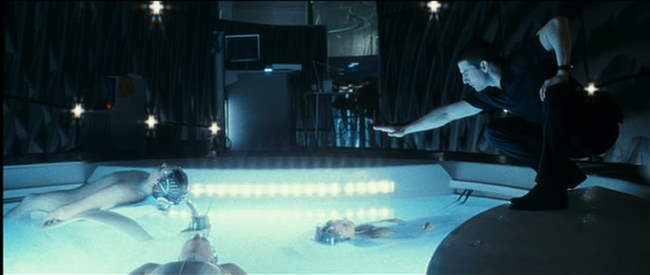
The end result of this technology is that people are being imprisoned for the crime PRIOR to committing it. Those who are identified by the Precogs are immediately sentenced to a strange virtual prison, where they are stuck in perpetual dreamstate (no word is given why they aren’t relegated to a normal prison). Through a quirky situation, John Anderton is brought in close proximity to the Precog, Agatha – she grabs him and fervently relays a vision that has occurred in the past. In tracking this down, John Anderton learns that sometimes one of the three Precogs actually deliver a vision that differs from the other two. This vision, termed a “Minority Report” is quickly discarded so as not to be seen as threatening the integrity of the process.
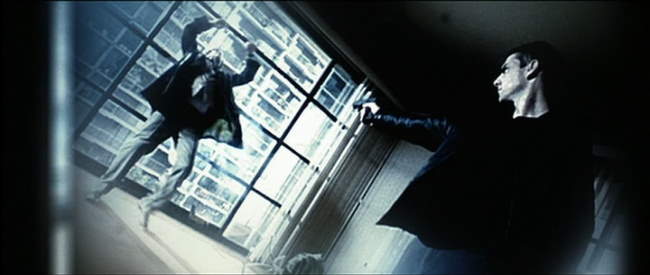
Anderton, plagued by the death of his son by an unknown assailant prior to the Precogs, has traditionally been the program’s biggest proponent. However, after learning of the Minority Report, he becomes concerned with the possibility that he has in fact been putting innocent people away. But unfortunately, his investigation into this matter has created powerful enemies. A new red ball vision is created, only this time Anderton finds out that HE is supposed to commit a murder in 36 hours. Convinced that he has been unfairly targeted, Anderton escapes from his former team and goes on a crusade to clear his name. His plight forces him to replace his eyes (used for retina scans at all security posts), and eventually takes him to the bottom of the Pilot Program’s seedy beginning.
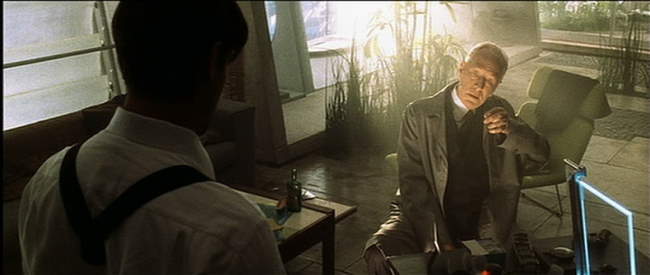
Story Issues : Nevermind the issue that the creepy hacker dude is able to jury-rig a vision scanning and extraction device faster than Scotty can fix a warp drive, Minority Report has a major issue with the technology that’s really never taken seriously – the issue of freewill. If precogs really can see into the future and determine that someone “will” murder their intended victim, this negates the ability of choice at that last instant of the murder. While this is eventually addressed (no spoilers), there is no rationale provided for why freewill was ignored. In the end we are left with believing that over-zealous law enforcement personnel were able to convince the entire country to take this approach. While this is a fine plot point, it would have been far more believable had their been some indication that they actually had to do a massive conving job.
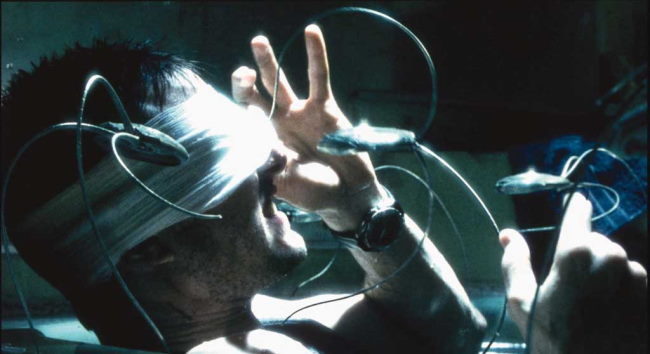
The Eyeball – the Ultimate Security Breach: The other issue with the story that really defies believability is that when John Anderton is caught, he is CONTINUALLY able to get back into the most secret areas of Police HQ by using his former eyeballs, which he keeps with him in a plastic baggie. Even though the police know he’s on the lamb, the apparently don’t feel the need to revoke Mr. Anderton’s security access privileges. This is all the more disbelievable considering EVERYTHING in society is apparently keyed off a retina scan. Sure, OK, perhaps one time they lapse on this, but three times??? Common Steven – you’re too good a story teller to let that one slide.
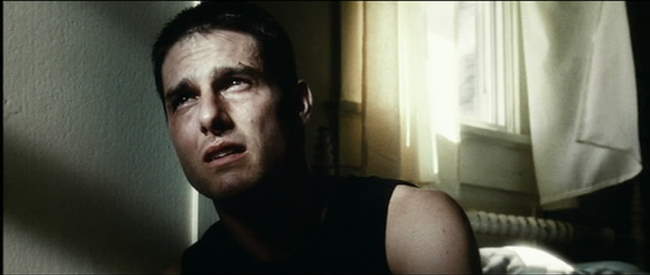
The Visuals: The visuals are sleek and well integrated, with some nice aqua and blue tones throughout. Interestingly, Spielberg usually goes with an overexposed type of shot to make it look almost as if one is looking at a dream sequence. Continually, we get white saturation dominating the shots. While this approach sounds weird, it ends up working wonderfully in adding to the mood of a cyberpunk film that has a massive focus on visions and dreams. As always, Spielberg gives us a plethora of truly unique visuals and mood shots. The best of the movie comes when Agatha
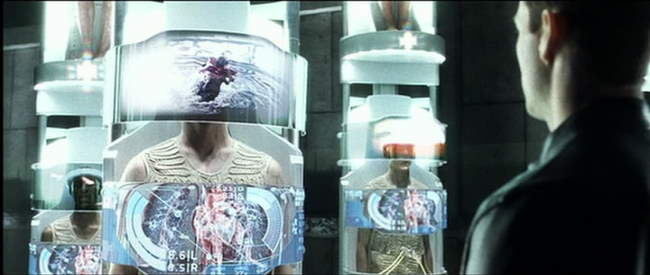
The FX: Minority Report consistently has absolute top-notch FX that adds interesting elements to the story. From the strange spider surveillance things, to the Boba Fett Police Podships, to the mixed modern cityscapes, the world of Minority Report comes off as a truly odd cyberpunked future. At some level, everyone seems to be living normal lives. Yet every now and then, we get a sense that the surveillance society has taken hold to the point that people have all just accepted it.
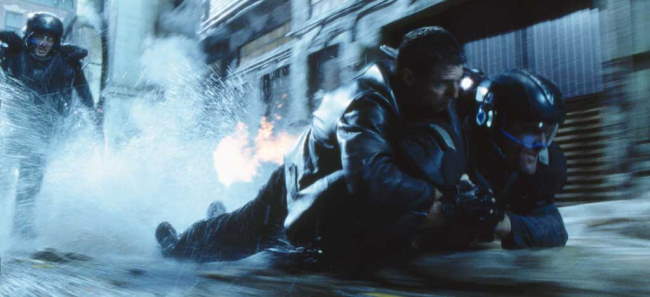
The Bottom Line: The overall mood and FX in Minority Report are terrific. The acting is great - Cruise has rarely been better, but also Von Sydow as the Police Director, Collin Ferrel as the scheming FBI agent, and Samantha Morton as the Precog are all terrific. The FX and sound If you buy the technology, chances are you give Minority Report at least a 9 or 10 star rating. Unfortunately, I did have problems buying some of this. Regardless, the story issues don’t take too much away from a very worthy cyberpunk film.
Page 2: More Screencaps–>>
~See movies similar to this one~
Movie Review By: SFAM
Year: 2005
Directed by: Michael Bay
Written by: Caspian Tredwell-Owen, Alex Kurtzman & Roberto Orci
IMDB Reference
Degree of Cyberpunk Visuals: High
Correlation to Cyberpunk Themes: Medium
Key Cast Members:
Lincoln Six Echo/Tom Lincoln: Ewan McGregor
Jordan Two Delta/Sarah Jordan: Scarlett Johansson
Merrick: Sean Bean
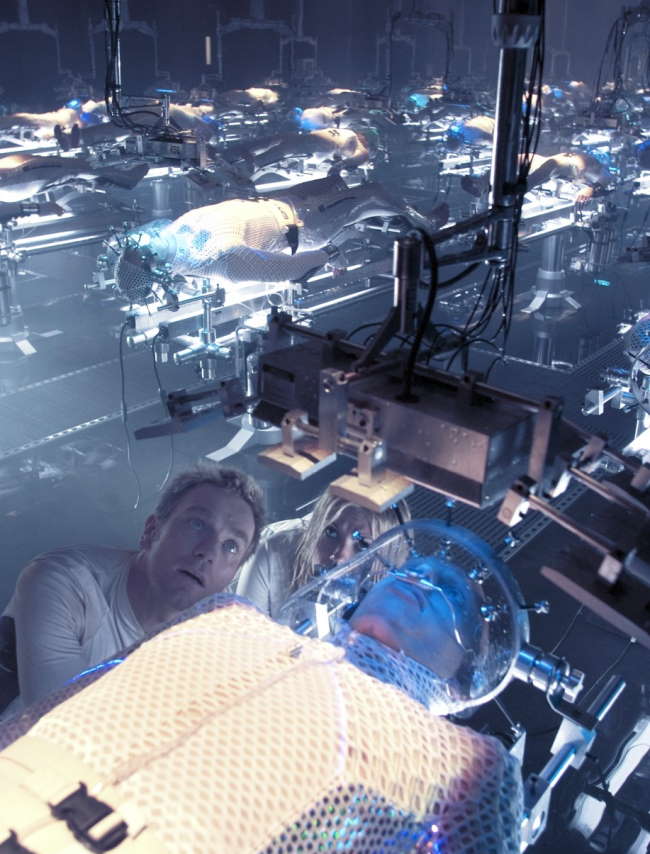
Overview: The Island is straight Hollywood fare from the get go. In this summer bubble gum scifi-action romp, you’ll find few original ideas here, or even a coherent plot, but you will find loads of awesome visuals and even more action scenes and explosions. Vast amounts of money went into creating some rather incredible action sequences. Unfortunately, with all the thought devoted to creating those sequences, there apparently was little left for the story itself. Still, Scarlett Johansson looks absolutely gorgeous in The Island, and Ewan McGregor works as a leading man.

The Story: In the future, the desire among the rich and famous to live for ever dominates their existence. Along comes Dr. Merrick (Sean Bean) who founds the Merrick Corporation to meet this market need. The Merrick Corporation has (supposedly) found a method to take a person’s DNA and clone all of their organs within a gelatinous blob that maintains a persistent vegetative state. Unfortunately, they were never able to make this work, so instead, the Merrick Corporation broke all the laws and went with straight cloning of their human sponsors. For a cool 5 million bucks, sponsors can buy an insurance policy to ensure they always have a perfect set of organs that can be harvested to save them from whatever malady arises.
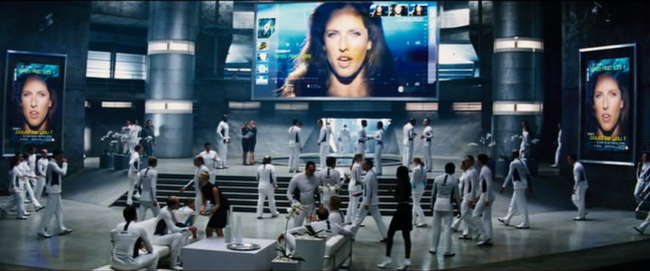
To keep the clones under control, Dr. Merrick constructs an alternate reality where a contaminated world has killed everyone except for a few fortunate souls who were rescued and placed into a special set of buildings. They have also saved an Island, which is now the only place on earth where people can live without dying. Now all the clones await their turn in the lottery, which, if won, supposedly means they will be able to go to the Island. In reality, the clones are “selected” when their sponsor has need for one of their body parts. From their diet to their associations with others to their urine output, every aspect of a clone’s life is monitored. THX-1138’s surveillance society, right down to the oppressive white, is omnipresent in The Island.
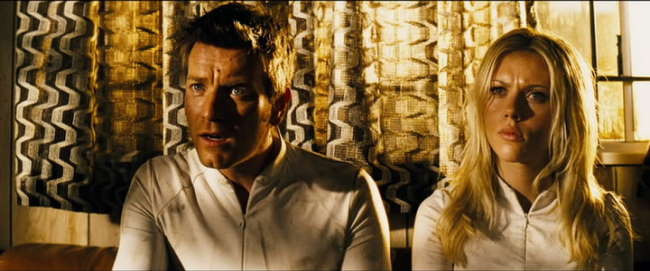
Lincoln Six-Echo, played by Ewan McGregor, is a clone who starts questioning his surroundings. He eventually gets out (through a completely idiotic plot point) and realizes that that those who leave to go to the Island are in fact being murdered. He quickly goes back to get his close friend, Jordan Two-Delta (Scarlett Johansson) who just yesterday was selected to go to the Island (her sponsor is dying from wounds suffered in a car crash). Together, they make a break for it, but are pursued by (we are told) a crack-group of ex-special forces agents led by Djimon Hounsou. With the help of a low-level employee (Steve Buscemi) that Lincoln Six-Echo befriended, Lincoln and Jordan make for Los Angeles in an attempt to find Lincoln’s sponsor to discover the truth. From there, The Island turns into a high-tech, futuristic chase movie, with continually larger explosions and action sequences dominating screen. I won’t spoil the ending for you, but suffice to say this movie is as predictable as they come.

Michael Bay’s Approach to Story Telling: It’s pretty clear that director Michael Bay doesn’t plan movies like most directors. He seems to pay FAR more attention to the visual progression than he does the actual dialogue. The narrative in Island, like most of his movies, simply doesn’t hold together. To buy it, you have to accept all sorts of inane action on the part of the characters. Michael Bay seems to construct his movies via storyboards alone – for instance, he knows that in the end, the hero and the bad guy need to fight on a high-tech, scary looking bridge with explosions going on in the background – he is far less concerned about the rationale that brings them together. In watching it, the Island is one of those rare movies that is actually more coherent if you turn off the sound. The story you make up to go with the visuals will almost certainly make more sense then some of the plot points Bay provides.
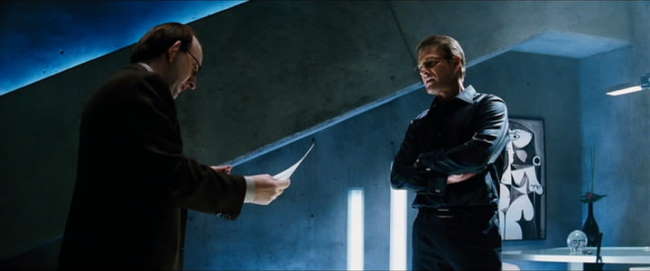
I don’t even mind that we have to accept that two clones, three and four years old, are able to outwit an entire platoon of ex-special forces personnel, or that they “magically” assume all of their cloned person’s skills (like riding flying motorcycles). I can even accept that a supervisor on a regular basis, gives a clone a key that gets him to the outside world to save the supervisor from running errands, or that the the police regularly park their squad cars in the middle of an intersection and then don’t look for broadsides, but some of the basic plot stuff really does bother me. In the Island, the cloning is a HUGE secret that implicates the entire corporation into illegal action, but none of the investors, including the Defense Department which as spent 120 Billion on this “technology,” ask any questions. Even more incredible, none of the hundreds, if not thousands of low-level employees have ever consider spilling the beans. Instead, they are so closed-mouthed, they don’t even tell their family members. Killing is cool for them, as long as they get to keep their meager paychecks. This is just one example – far worse are the ending plotlines, which have our heroes assuming that top-notch special forces personnel wouldn’t search them for weapons even after they’ve shot people (lucky for them, the special forces personnel complied), that hired thugs would hang out and watch their boss go mono-a-mono with the hero vice wasting our hero, and that the boss himself, up in the comfort of his office, would be able to make it to the hero far quicker than any of his hundred thugs who’s job it is to enforce the peace.

Product Placement Gone Wild: It’s kind of refreshing to know that in the future, all dehumanized clones have to wear Puma shoes and clothing, drink Aquafina, serve Ben & Jerry’s Ice cream to kids, model for Calvin Kline on billboards, play Xbox, seek out MSN Search as a phone book, conduct their slave work on Apple computers, steal American Express credit cards, snag rides on Mac Trucks, wear Monza watches, and look longingly at Michelob Light beers. And of course, EVERYONE will be driving either Cadillacs or Dodge Magnums in the future. The Bond movies, where you expect significant product placement, don’t hold a candle to the monstrosity that is The Island. Not only do we get an obscene number of product placements, the on-camera product “lingering” that Mr. Bay engages in is almost criminal. I felt like I should have gotten a discounted ticket due to the myriad of embedded commercials. It’s rather amazing if you think of it – that almost 70 years into the future, all these companies will still be using the same logos they use today. I must say though the product placements are very memorable – they make be both remember the product and more importantly, they instill in me the STRONG desire to never buy these products again, as I now associate these brands as contributors to fucking up my movie watching experience.
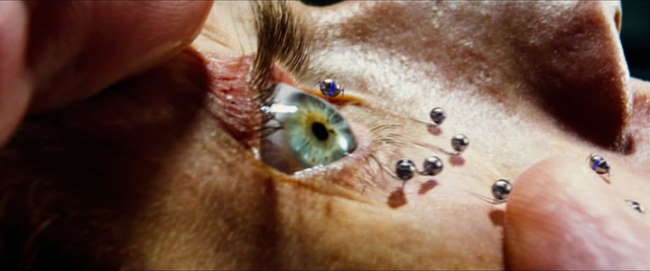
The Visuals: While I’ve bashed the Island’s plot, Michael Bay certainly deserves a lot of credit for delivering some pretty cool cyberpunk visuals. The clone development labs look pretty darn cool. Additionally, Michael Bay continually composes shots displaying wonderful color panoramas. We get gorgeous yellows and blues in a variety of textures and settings. In scene after scene, it becomes clear that while Bay isn’t too concerned about the dialogue or narrative sequences, he’s intimately involved in the look. In some cases though, the visuals, while impressive, make absolutely no sense – the worst example being the weird eye-nanobots that are needed to take pictures of the brain activity. That its necessary to have metal insects entering the eye in order to take a brainscan 70 years into the future strains credibility far past the point of reason – even worse, the brainscan cannot be processed until 48 hours!
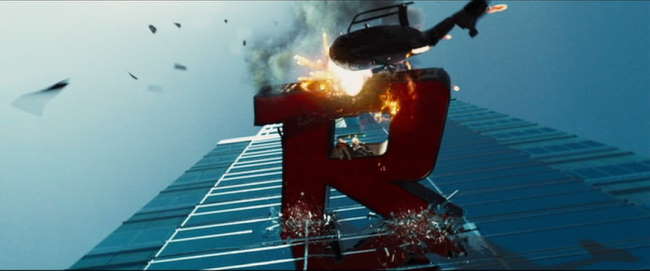
The Action Sequences: Michael Bay is known primarily for his outrageous and visually impressive action sequences. He does not disappoint in the Island as the action is consistently top notch. We get awesome explosions, incredible chase scenes and lots of gun fire and fight sequences, all with wonderful camera angles and high quality positional surround sound. If there’s one reason to definitely not miss the Island, it’s the action sequences. Michael Bay may not be a great film maker, but he and his crew are genius at constructing creative, eye-poppingly tense action.
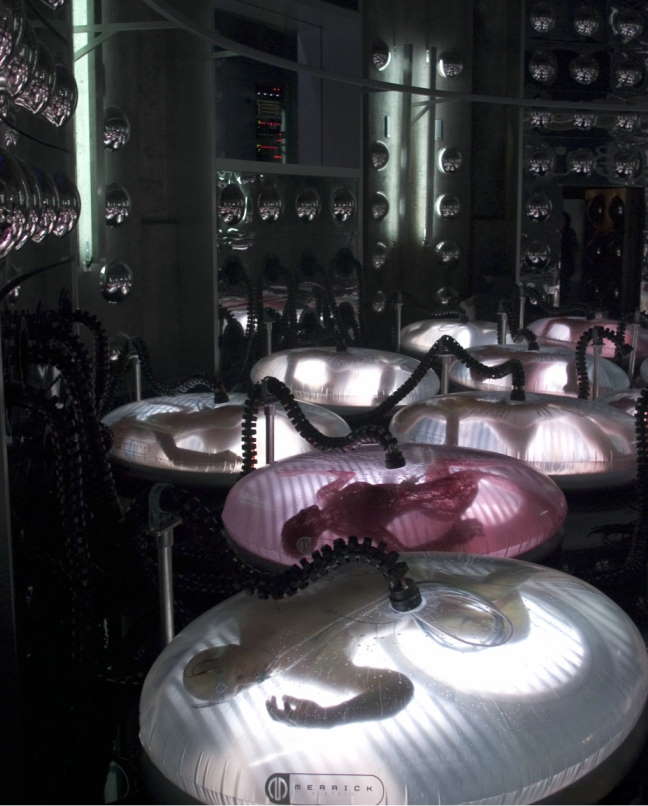
The Bottom Line: If there was one change I would make to the story, I would have suggested they had done away with the illegal nature of cloning (the second change would be to eliminate the magical memory transferral that happens between clones and sponsors). The Island would have worked far better if it portrayed a world were society as a whole had decided that cloned people were property. Instead, the Island practically ignores this question. But while I have a hard time suspending disbelief for the plot the Island provides us, I probably would have given it six stars, similar to a number of other Hollywood movies high quality visuals and significant plot issues. Unfortunately, the obscenely over-the-top product placement deserves at least the loss of one star. Not only are there over a dozen companies, the “linger” factor makes it clear that you’ve just paid to watch a commercial. In the end, this is simply asinine and reflects poorly on the studio (Dreamworks), the film maker (Michael Bay), and the products themselves (too numerous to mention). I would conservatively guess that the product placement easily cost the Island many tens of millions in lost revenue. The Island cost 126 million to make but only brought in 35 million, large part because virtually all reviews discussed the overbearing product placements. Word of mouth from viewers merely confirmed that if you pay to watch this in the theatre, you will be paying for commercials.
~See movies similar to this one~
Movie Review By: SFAM
Year: 1985
Directed by: Terry Gilliam
Written by: Terry Gilliam, Tom Stoppard & Charles McKeown
IMDB Reference
Degree of Cyberpunk Visuals: High
Correlation to Cyberpunk Themes: High
Key Cast Members:
Sam Lowry: Jonathan Pryce
Jill Layton: Kim Greist
Archibald ‘Harry’ Tuttle: Robert De Niro
Mrs. Ida Lowry: Katherine Helmond
Michael Palin: Jack Lint
Spoor: Bob Hoskins
Mr. M. Kurtzmann: Ian Holm
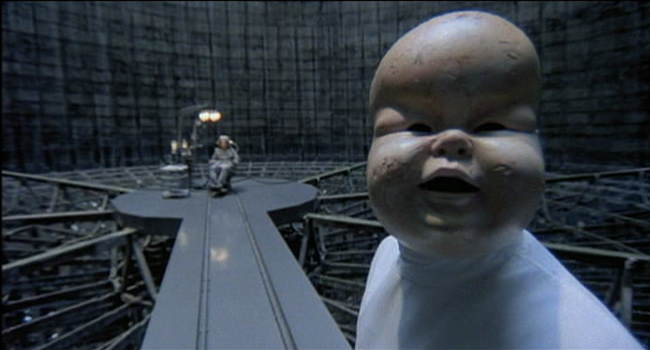
Overview: Terry Gilliam describes Brazil as “Franz Kafka meets Walter Middy” - this sort of fits. Using the name of Arry Barroso’s 1930s escapist song, Brazil is set in a nightmarish, fantasized dystopic future, Gilliam gives us a story about humanity attempting to escape reality by retreating into one’s own dreams. This is all the more interesting given the enormous fights Terry Gilliam had to engage in with Universal to even get the picture (in a non-bastardized form) released. Brazil is a visual and thematic tour-de-force which deserves a watch by all who are interested in having movies provoke deep thoughts, long after the film has concluded.
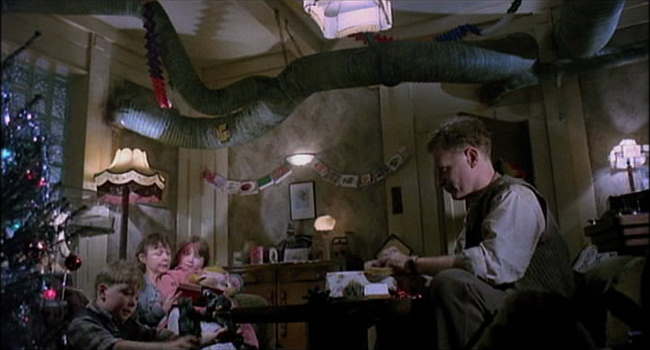
The Setting: Brazil takes place in a fantasized dystopic future where runaway, controlling, technocratic bureaucracy that has invaded all aspects of daily life. Arcane forms with incoherent instructions are required to do anything, but the goal is always completeness and finality over actual results. Appearances are everything in Brazil – actual human relationships are a luxury most do without. Humans survive in this world by keeping their “real” selves bottled up inside as a cocoon, while overtly they serve their role as a specific cog in the system. Keep the desk clean, the expensive suit pressed and your family looking perfect and you’ll be alright. Continually we see non-human responses to horrific disasters. In one restaurant scene, half the patrons have been blown up by a bomb, but the maître d’ is far more concerned with hiding the destruction from his elite patrons by erecting a pleasant backdrop than he is in helping those horribly injured.
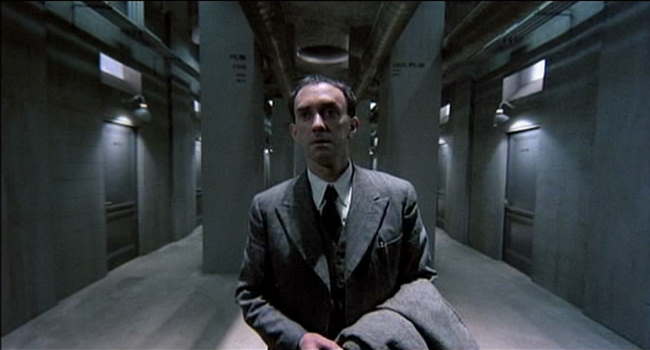
The Story: Sam Lowry (played wonderfully by Jonathan Pryce), our hero, from the beginning adapts to the system, but separates his “true” self in his dreams. Sam works as a minor cog in a the massively large bureaucracy called the Ministry of Information. The Ministry of Information eats up 7% of the total GDP in its pursuit of society’s subversive elements, including the terrorists, who randomly bomb the rich and wealthy throughout the movie. Even though Sam comes from a prominent family with connections, he wants nothing to do with career advancement. Sam long ago gave up aspirations, and only wants to get through life unnoticed - until the love of his dream life appears in the real world. Sam throws everything else aside in order to meet up with this chick, but unfortunately, the “system” and even his own preconceptions continually get in the way. As the story unfolds, we see the bureaucracy in action in what becomes a struggle of freedom and individuality against the technological domination of humanity.

The Visuals: Brazil is a visually powerful movie. In its more sedate moments, Brazil starts off as a noir-ish style setting with 40s style suits and hats, tall squared buildings, computers driven by typewriters and dark lighting from above. But very quickly, Brazil changes to a surreal experience, which shoes converted to hats, ventilation pipes dominating every roomscape, and massive expansive buildings without ground floors. Ventilation pipes are Gilliam’s symbol for technology run rampant. Massively tall buildings are symbols for bureaucratic power. Throughout, dark gray is the dominating color. Visually, the world of Brazil is decidedly bleak – more bleak in fact than humanity can overcome.
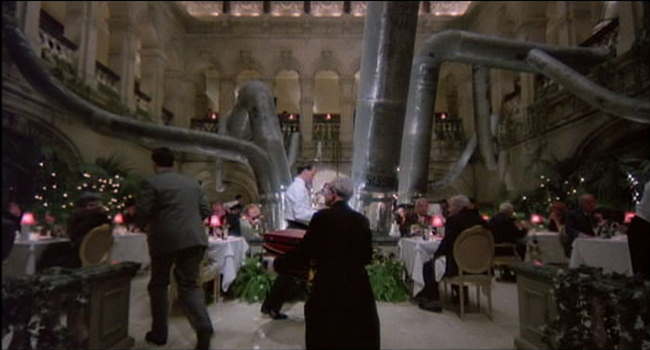
The Sound: Brazil’s score fully encapsulates the ambiance that Gilliam is expressing. We have high flowing orchestral pieces, cheesy, squeaky monophone songs, marches that integrate type-writers as the rhythm section, and all sorts of diversity that captures the quirky, bittersweet feel that Brazil often conveys. The continually harsh, metallic sound FX also highten the ambiance. What we are left with is a wonderful meshing of visuals and sound as a backdrop for the wonderful performances throughout.
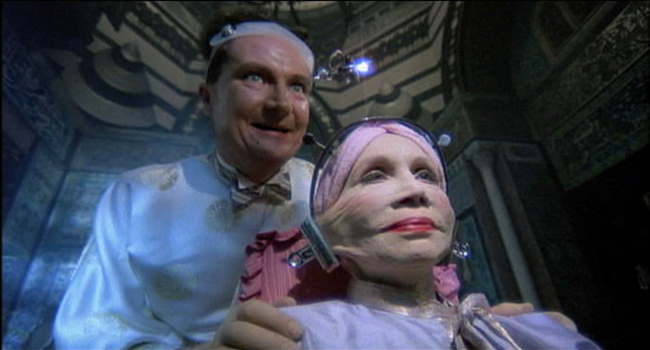
The Cast: One of Gilliam’s real skills in Brazil is taking an extremely large cast, filled with potentially interesting roles, and making them all meaningful. Continually, Brazil provides us a stream of totally interesting role players that add to the quirky universe that is this fantasized future. Robert De Niro is terrific as Harry Tuttle, a heat engineer-turned anarchist revolutionary. Michael Palin plays a terrific best friend and torturer, and Katherin Helmond plays a totally wierd, excentric but powerful mother. There are a number of other unique roles, including Ian Holm who plays a terrific cowardly, conniving boss, and Bob Hoskins as a slighted and crazed heat engineer. Jonathan Pryce is absolutely superb as the lead, and Kim Greist plays an interesting counter-point love interest. All in all, the roles come across as entirely memorable.
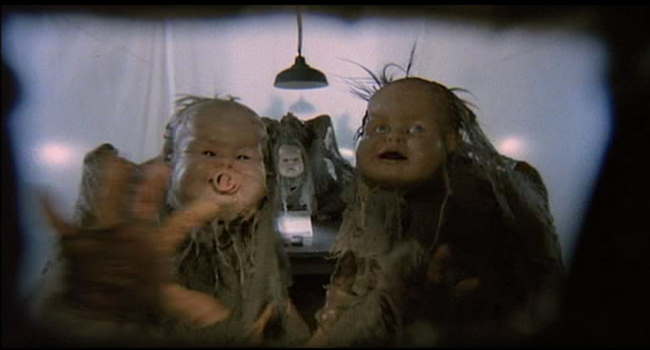
Dream Trapped Inside of a Nightmare: On the “Making of” segment of the Criterion Edition, Brazil is described as a dream trapped inside of a nightmare by star Jonathan Pryce. Pryce’s character, Sam Lowry, dreams the ultimate dream of happiness. In his dream, he is a fantasy warrior with angel wings who fights the denizens of the deep to rescue his idealized damsel in distress. In reality though, every aspect of his life is a nightmare. The “system” that is the bureaucracy, in an attempt to root out the terrorists, has extended its omnipresent tentacles into every aspect of life. At best, Lowry’s idealized reality involves being un-noticed by anyone. Unfortunately, once he discovers his idealized mate in real life, he can no longer remain obscure. He risks everything in a failed attempt to transform his dream into reality. In the end, Brazil shows how the depths of humanity can be crushed in a dystopic future where individuality and human rights become completely subservient to societal “welfare.”
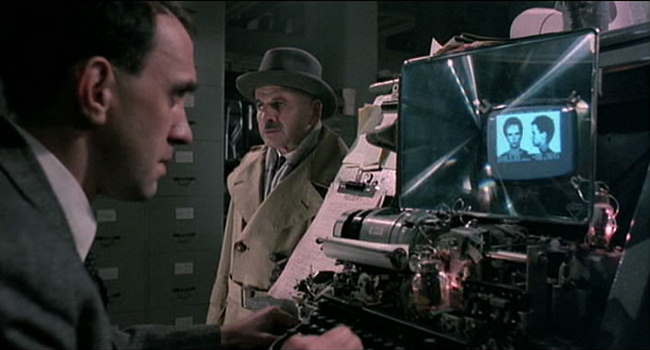
Use of Information: In Brazil, the collection and storage of information is paramount. While Brazil takes place in a dystopic future, computers have never advanced past arcane mainframes. The notion of usability, or people-centric computing is an anathema to the world of Brazil. The horror of horrors for the bureaucracy is finding a piece of paper without a home, or even worse, acknowledging that the “mistake” that caused this out of place paper belongs in your department! In Brazil, the fact that a person dies and a family is destroyed by this paperwork glitch is completely beside the point. In fact, the Samurai warrior character (see below) that Lowry fights in his dreams is fully comprised of computer parts – information and computers are indeed the ultimate evil for humanity.
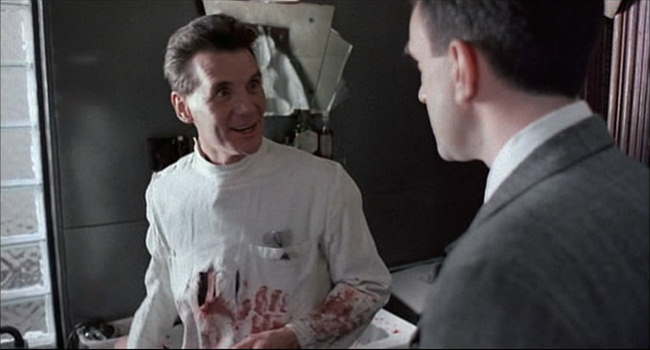
Terror As a Means of Extracting Information: One of the really interesting notions in Brazil that resonates today is the idea that the government engages in torture as a means of extracting information about potential terrorists. The throwaway comments from Sam, who has bought into this world, indicates that the choice HAS to be between this invasive government and sheer anarchy. When brought to the level of the individual, one has the sense that little by little, the government in Brazil slowly invaded individual freedoms as a way of combating the terrorists. The clear impression though is one of ever escalating acts – as the government becomes more invasive, the anarchic responses become more extravagant. De Niro’s character, the heroic anarchist heating engineer, represents this history of society, and humanity’s ultimate response.
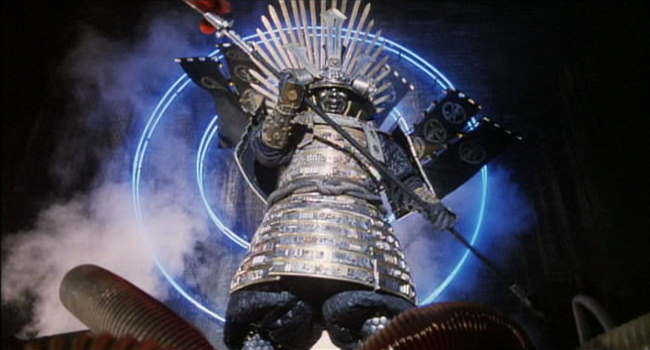
Is Brazil Cyberpunk? Due to the fantasy elements we see in Brazil, it’s hard to refer to it as a straight cyberpunk movie. While the dream sequences aren’t an issue, the dystopic future clearly isn’t supposed to represent an actual near-term future – it’s a fantasized version of issues currently playing out in society today. Still, the message of invasive technology and dominating totalitarian control destroying humanity is rarely done better than we see in Brazil. And while Brazil is wonderfully quirky, it’s the ending that truly feels like a cyberpunk film. Here we get both common cyberpunk visuals and philosophy in every sense of the word. The ending especially mimics many other cyberpunk films, where…
[SPOILERS – HIGHLIGHT THE TEXT TO SEE]
Throughout the last half of the film, Sam’s perception of reality becomes more and more governed by perceptions from his dream world. His actions leading to his final arrest are based on a perceptual mix of fantasy with reality. At the end, Sam is seems to make the conscious choice to disavow the real world in favor of his internally constructed fantasy. In this sense, Sam has finally attained the freedom he long sought after. Interestingly, a very similar approach is also used at the end of Save the Green Planet.
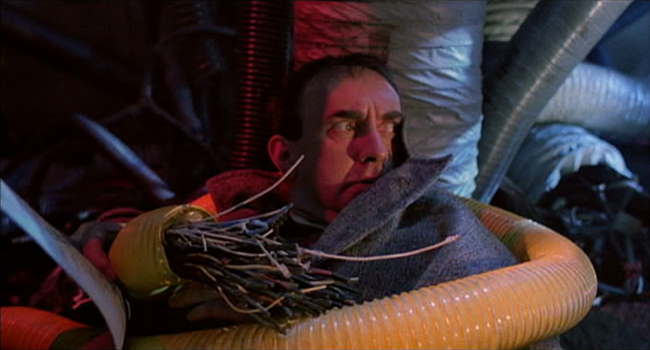
The Bottom Line: The world of Brazil is steeped in a runaway, controlling, technocratic bureaucracy that has its tentacles in every part of humanity. The ducts dominate every room, including the family household living room at the beginning. To humanity, the message is clear – “Your actual lives must be adapted to suit OUR needs, not yours; freedom now only exists in your own dreams.” In the end we are shown the myth of a free man in a tightly controlled society – the only freedom we ultimately possess is within our own perceptions – that is the only source where salvation can be found. Visually, Brazil is simply stunning. The story is incredibly creative, the acting is great (especially De Niro and Pryce) and the dialogue is terrific. Furthermore, your Gilliam’s wonderful sense of humor seeps out of every pore in this movie - such as the notion that the information retrieval department never retrieves any information. In short, Brazil is movie worthy of high praise.
Go to Page 2 for More Screencaps–>
~See movies similar to this one~
Movie Review By: SFAM
Year: 2005
Directed by: Karyn Kusama
Written by: Phil Hay & Matt Manfredi
IMDB Reference
Degree of Cyberpunk Visuals: High
Correlation to Cyberpunk Themes: Medium
Key Cast Members:
Aeon Flux: Charlize Theron
Trevor Goodchild: Marton Csokas
Oren Goodchild: Jonny Lee Miller
Sithandra: Sophie Okonedo
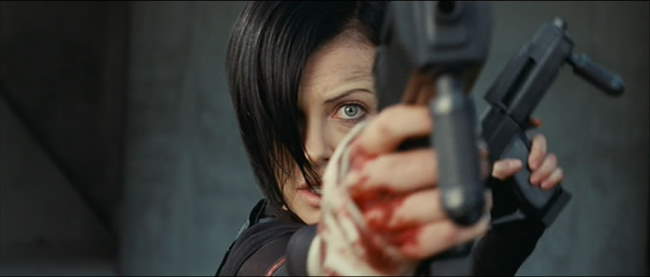
Overview: In the best of cases, remakes of cherished shows rarely turn out good. The MTV Aeon Flux cartoon series was an intensely creative post-modern show by Peter Chung, who broke all the rules of how narratives are supposed to be told. The lead character, Aeon Flux, the ultimate anti-heroine, dies on a regular basis; nobody was purely evil or purely good; and everything was high-tech body modification chaos. Unfortunately, the movie does away with all that. In an attempt to “humanize” the iconic figure of Aeon Flux, the movie version goes for a standard rebels-versus-Orwellian bad guys movie with a twist. While some of the visuals are absolutely terrific (including some wonderful action scenes by Charlize Theron), in the end, this is a very different story with very different characters, and must be understood as such.
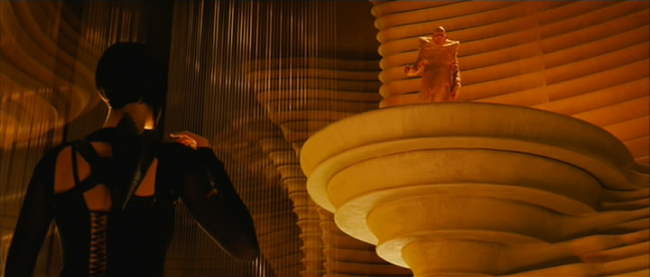
The Story: Aeon Flux takes place 400 years after a virus has devastated humanity, killing off 99% of the population. Now, one walled city named Bregna, holding 5 million people is all that remains of humanity. Bregna is ruled by a council of genetic scientists who have (supposedly) been avidly working on fixing the fallout of the virus for the past 400 years. For reasons only partially explained later in the story, the ruling council has instituted a totalitarian government with an extreme crackdown on personal freedoms, and have backed their authority with an intense surveillance apparatus. A group of rebels called the “Monicans” have challenged their right to rule, and have vowed to destroy the ruling council, especially their leader, Trevor Goodchild (Marton Csokas), at all costs.
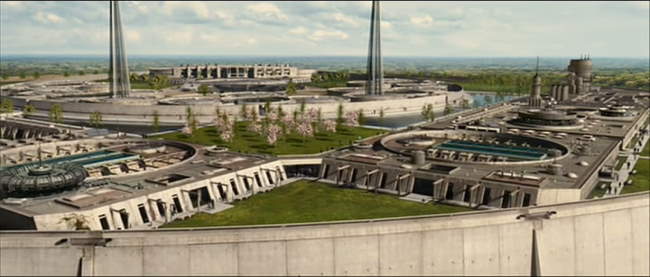
Aeon Flux (Charlize Theron) is the Monican’s very athletic, butt-kicking, black spandex wearing operator-extraordinaire. No mission is too dangerous, and no obstacle is insurmountable. In what serves as the prologue, Aeon’s last surviving family member, her sister is killed by the Bregan Council authorities – all that remains for Aeon is revenge and the mission. Finally her time comes when the fiery-haired Monican handler (Frances McDormand) authorizes her to go assassinate Trevor Goodchild. So Aeon and her partner with four hands and no feet, Sithandra (Sophie Okonedo), storm the garden and infiltrate the Brega Council compound.
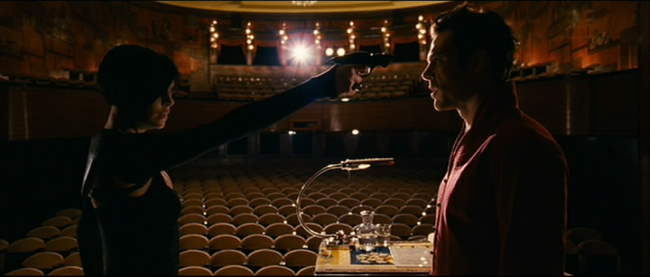
Unfortunately, as Aeon finally encounters Trevor, not all is at it seems. She suddenly has memories of kissing Trevor in a former life. Worse, it looks like there are other forces at work, and perhaps Trevor isn’t the bad guy the Monicans have made him out to be. As Aeon follows her heart and the ever expanding mystery, she engenders anger from the Monicans, while Trevor ends up at the wrong side of a coup-des-tat at the hands of his evil brother, Oren Goodchild (Jonny Lee Miller).

Story Problems: While the front half of the Aeon Flux story works, the back-end is riddled with inconsistencies. If you spend an ounce of time thinking through the motivations, the actions of the main bad guy make no sense. What he really wants (immortality) can be accomplished even Trevor’s experiments prove successful. This is muddied further when the Jurassic Park mantra, “Nature finds a way” is added to the mix. Even weirder is Pete Postlethwaite’s character, who comes across almost as the watcher in a Fantastic Four comic. We are never sure if he is real or Memorex. Worse, his final monologue where he explains his actions adds yet another strange element to the scifi-mix – precognition. In the end, there are too many fantasy-like technologies for this to come across as believable. In brief discussions with on the writers (Phil Hay), it appears that the original script might have been tampered with. I really hope this is the case, as the visuals of the movie were more than strong that they would work for even a passable story.
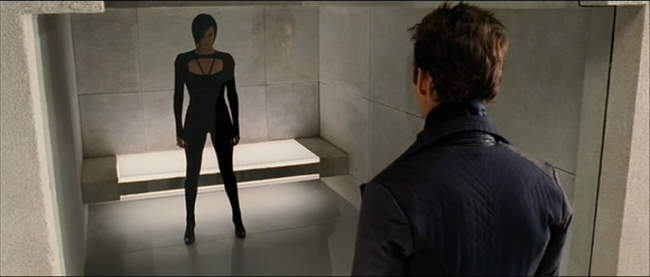
Changes With Aeon and Trevor From the Cartoon: The move version of Aeon Flux in no way matches the lead characters of Aeon Flux and Trevor. In Peter Chung’s cartoon, Aeon Flux comes across as the ultimate anti-heroine. While she clearly knows right from wrong, and generally tries to stop the worst abuses, Aeon is an ultra-acrobatic, top-notch action-espionage heroine who works for herself, and only operates under her own agenda. Trevor is a mostly malevolent, superior dictatorial character who as a true soft-spot for Aeon. For her, he will bend his approach, but otherwise he rarely is a nice guy. We rarely see fear, doubt, or self-loathing out of Aeon, although she too has an eternal love for Trevor that trumps all. Kusama’s version of Aeon and Trevor tries to humanize them, and in doing so, removes much of their uniqueness and appeal. New motivations and afflictions are created where none previously existed. Worse, their very nature changes. In the end, Trevor turns out to be a misunderstood hero who works valiantly to save humanity – his only fault is he turns a blind eye to his brother’s excesses. Aeon becomes an agent working for others goals, but only later turns to herself based on principled evaluation of what is right and wrong. Again, while both of these characters may be interesting if done well, they bare little resemblance to the mindset of the Aeon and Trevor characters from the original show.

Still, I must give credit to Charlize Theron’s athletic feats in this movie. By all accounts she spent 3 months training to be a gymnast and fighter, and it shows. While for the most part she does away with the ultra skimpy clothes from the cartoon, she really does nail the gracefulness and style of the cartoon Aeon Flux. And while I don’t necessarily agree with the humanization approach, Aeon does pull this off very well, especially considering she has very little dialogue. The fact that she got seriously injured on the tenth day of shooting (herniated disc injury), but came back to continue the vast majority of the stunt work is a testament to her commitment and professionalness, and should be applauded. If I had one complaint with her protrayal, she really doesn’t really “look” the part, in that the cartoon character was a taller figure with a far more angular face and tapered hair.

Editing is Way Too Frantic: Aeon Flux was a very contemplative animated show. Almost always, you had time to properly digest a scene. The atmosphere of the original series is largely based on the pacing. In the movie version, the editing seems designed to artificially hype the tension. In the end, it results in sucking the life out of many of the scenes. You rarely have time to feel connected to the scenes. More often, you feel like you’re riding a roller coaster, even when the scene is nothing more than two people talking.

The Technologies in Aeon Flux: The body modifications (such as hands replacing feet, and various stuff stored within the skin) in Aeon Flux really added to the visual appeal. Also, there were a number of interesting technological innovations. Probably the biggest was the peer-to-peer interaction in “brain space” that the Monicans use to elude the Orwellian-style surveillance systems that the council has set up. The flat metal slices that turn into semi-autonomous exploding balls were visually cool, as was the room that worked in two dimensions (each dimension of frequency holding completely different items). I also liked the bubbling Band-Aids that Aeon has stored, hiding on her skin.
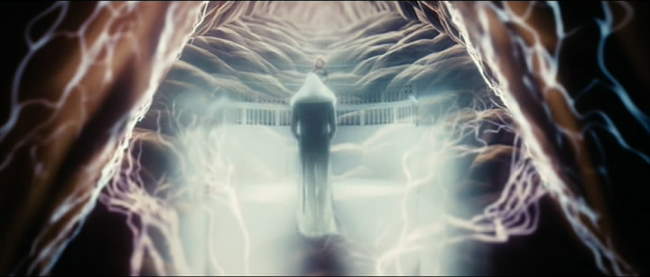
The larger technology involved cloning. In Aeon Flux, cloning equates to flawed reincarnation. With each generation the people are cloned, the memories of their lives somehow stay with their soul – yet with each time they are cloned, the new person has memories from the previous versions. Over time, the cloning ends up destroying each other’s reality. For the most part, I don’t think this idea worked all that well. It gets especially troublesome when we look at the Keeper, who seems to be able to “remember forward” and thus, make decisions 400 years ago that will help save the world well into the future.
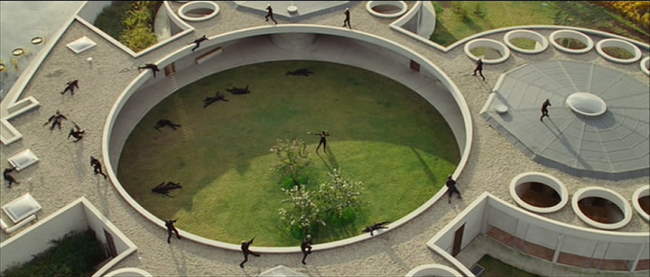
The Visuals: Visually, Aeon Flux is a gorgeous movie. We have also sorts of beautiful futuristic city settings, beautiful characters, and really fun FX. Some of the visuals are completely nonsensical though – the most egregious being an early scene involving Aeon wearing white for the ONLY time in the movie when she wants to stealthily sneak into the Brega compound at night. While this helped make Aeon’s character stand out more, it immediately brings a sense of Hollywood unreality to the whole affair. Still, while many of the action scenes didn’t make lots of sense, they were all nicely shot. Some of the fights were pretty gritty, but for the most part, the resembled a gun-version of a kung-fu dance movie.
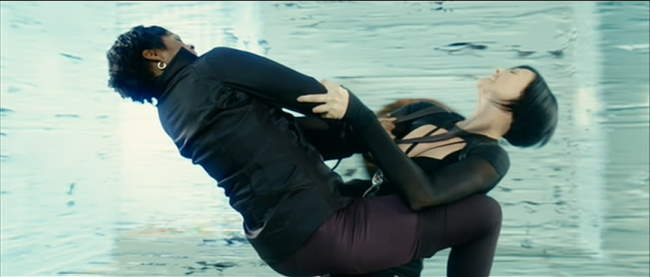
Lots of Hawt Chick Fighting! One of the better aspects of Aeon Flux involves the massive amounts of hawt chick fighting! Yes, its low-brow, but we like it. We get some really juicy fights between Aeon and Sithandra, and Aeon and Trevor’s bodyguard, Freya (Caroline Chikezie). And of course we have massive amounts of Charlize Theron in tight black spandex, kicking butt. While some have compared this aspect to Catwoman, the comparisons are unfair in that 1) we don’t have Mouseketeer ears, 2) all the fighters are very athletic, unlike Sharon Stone in Catwoman, and 3) the fight choreography is far far better.
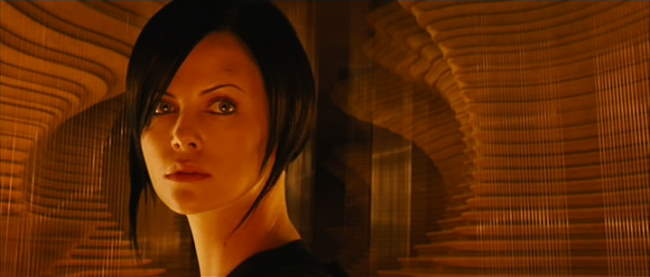
The Bottom Line: While there enough to like in Aeon Flux to give it a passing grade, I really can’t give it more than that. A movie version of Aeon Flux should have been a creative, postmodern event that stayed true to the cores of the characters in the cartoon. Evidentally, the studio thought an innovative approach such as this wouldn’t fly with the vast movie-going public. What was created instead, even though different, could have been decent, but was mired down with horrid editing choices and incoherent motivations in the later half of the story. In the end, it’s hard to buy a number of the decisions various characters made.
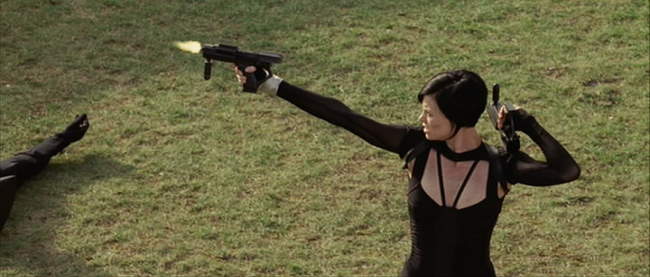
However, the narrative problems in Aeon Flux may be due more to ridiculous studio meddling than with the actual script – apparently the editing was one casualty of studio meddling. Phil Hay has indicated that he will write an essay on how the Director’s Cut would have been different. He is hoping that DVD sales will be high enough that the studio will agree to release the Director’s Cut, which he claims is a very different movie. Still, Charlize Theron’s excellent acrobatics makes for good eye candy, and turns in a credible performance as a humanized version of Aeon (the Trevor portrayal is completely uncrecognizable from the cartoon though). The visuals are terrific, and the technology is pretty interesting. Similar to other 6 star movies that are high on visuals but have problematic stories (Ultraviolet, T3, Appleseed), you may still be interested in giving this a watch.
~See movies similar to this one~
Movie Review By: SFAM
Year: 1995
Directed by: Peter Chung & Howard Baker
Written by: Peter Chung et. al.
IMDB Reference
Degree of Cyberpunk Visuals: Very High
Correlation to Cyberpunk Themes: High
Key Cast Members:
Æon Flux: Denise Poirier (voice)
Trevor Goodchild: John Rafter Lee (voice)
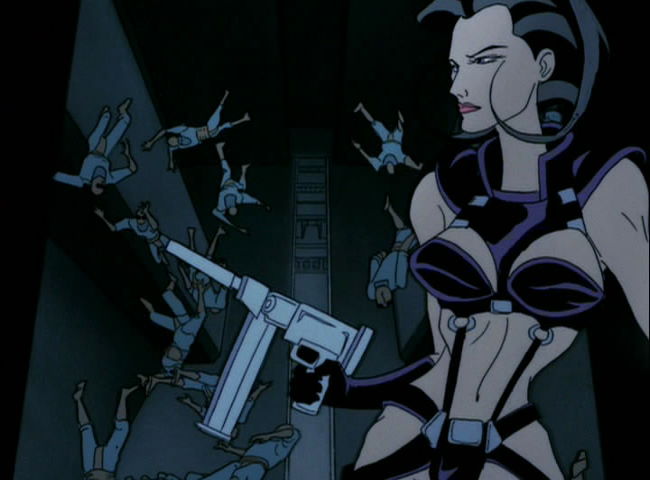
Overview: Aeon-Flux, the brainchild of Peter Chung (also the writer/director of the terrific Animatrix short, “Matriculated”), is one of the really innovative and unique animated shows to come out of the United States. We really have to thank MTV for allowing this show to get produced, and then, after realizing that they just couldn’t control it, for letting it go on unfettered for a second season. Aeon-Flux is not meant to be a coherent whole – this postmodern cyberpunk show is as nihilistic as they come.
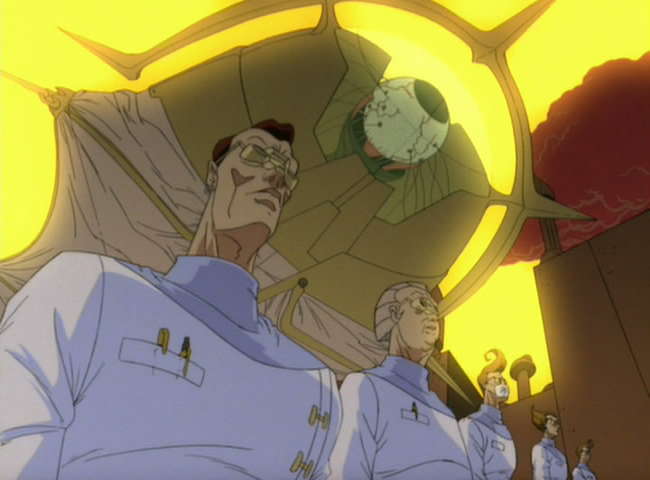
The Story: Aeon Flux takes place in a truly bizarre near-future setting, in which genetic engineering, body modifications, and excessive self-gratification are the norm – yet these extremes take place in a controlled surveillance society. Nearly all events take place in the utopian city, Bregna, which is controlled by a supreme oligarchy. Trevor (voiced by Vampire Hunter D’s John Rafter Lee), one of the two central characters, is a prototypical mad scientist who, at first seems to have little regard for anything other than his own perverted desires. As the show goes on, we find that he is in fact truly besotted with Aeon Flux, who, in many ways is his complete opposite. Aeon Flux (voiced by Denise Poirier) represents the forces of anarchy, and is continually involved in fucking up Trevor’s carefully laid scheming. Unfortunately for Aeon, she too cannot resist Trevor’s guile, which just as often, leads to her downfall.
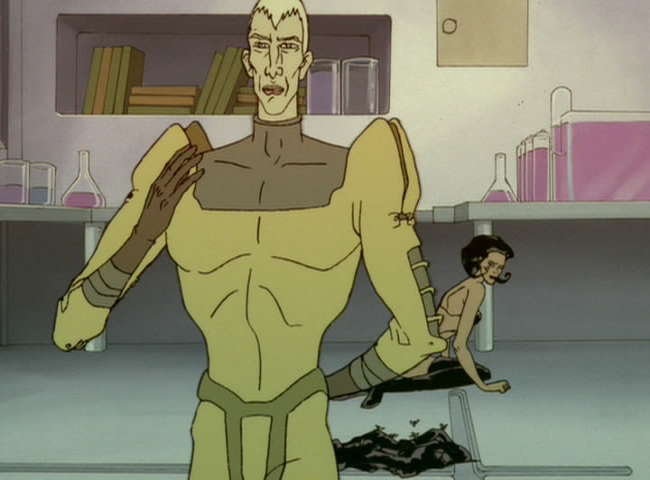
Virtually every episode is different in Aeon Flux, but all of them deal with a strange, fast-paced plot that deals with espionage in some way. Episodes usually have the feel of a chess match, where Aeon and Trevor match wits over completely strange and esoteric plots. More often than not, nobody wins. In fact, unlike most shows, the winning and ending itself is rarely important. This is not what the shows are about. More important is the mood, the feel, and the atmosphere that exudes from the visuals, the dialogue and the score.
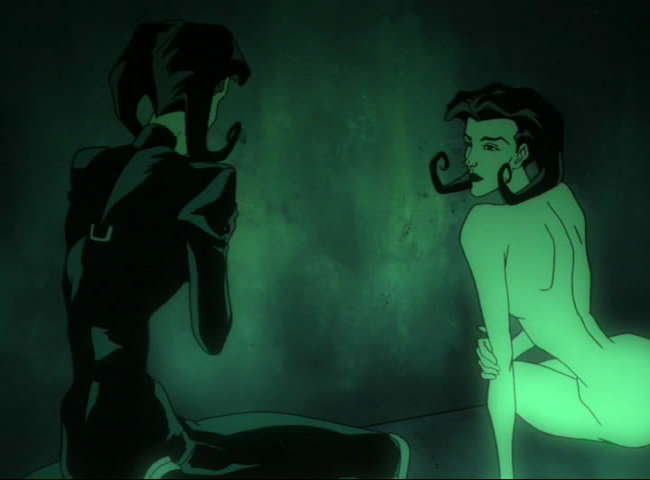
Spoiler – Aeon Flux Dies…A lot! Well, OK, it’s not really a spoiler. It’s more a fact of the show itself. Unlike most shows, in this one, the star dies regularly. Early on in the long shows, Trevor clones Aeon Flux, so thematically, there is now an infinite number of Aeons just waiting to bite the big one. And while there’s now a “rationale” for the deaths, this isn’t really the point – Aeon Flux isn’t meant to hold together that way. It’s almost as if each episode is completely it’s own show. But if she dies, rest assured it will happen in a truly innovative and gruesome way. It could be drowning in a vat of poisen, getting dropped out of a plane, being eating by bizarre genetically modified creatures, or, well, you get the idea. .

Aeon Flux – the Ultimate Anti-heroine? In many ways, Aeon Flux comes across as the ultimate anti-heroine. While she clearly knows right from wrong, and generally tries to stop the worst abuses, Aeon is an ultra-acrobatic, top-notch action/espionage heroine who works for herself. She’s just as likely to take an assassination job as she is to stop a horrid virus from killing mankind. Did I mention she’s drawn up in ultra-hot, skimpy clothes, and likes to have sex a lot? In this way, she really does qualify as a more female than female character (usually cyberpunk reserves these for cyborgs and androids). Most interestingly, because of Aeon Flux’s propensity for dying, you never know whether or not she’s going to make it through alive, or even whether she’ll complete her mission (she seems to fail almost as much as she succeeds). This really does add an excitement to the episodes.

The Love-Hate Relationship: Aeon-Flux and Trevor have a complete love-hate relationship. Even when they are bent on killing one-another, there is always sexual tension, which while often consummated, never leaves the two characters. Every episode gives us yet another chance to explore their relationship in a completely bizarre way. Trevor is definitely Aeon’s Kryptonite. More often than not, his presence alone is enough to make her botch her mission. However, this doesn’t stop Aeon from ruining most, if not all of Trevor’s take over the world plots.
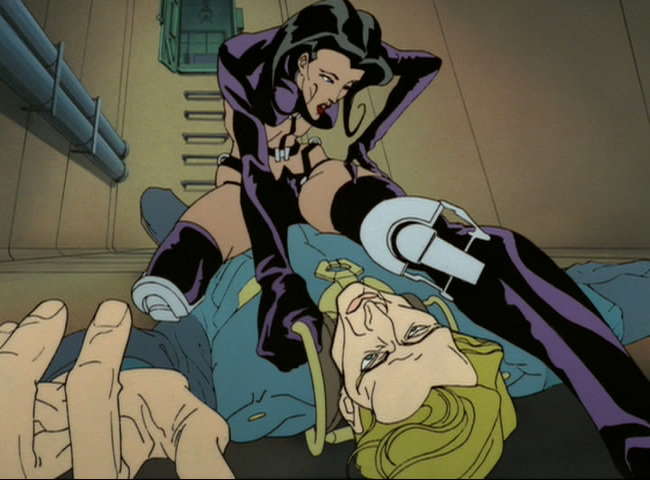
The Visuals and Cinematography: Aeon Flux gives a number of different looks as the show progresses. Perhaps my favorite are the perspective shots such as the one above. We also get lots of wide angle shots, strange close-ups, gradients, and a number of truly surrealistic sets. Unlike most cyberpunk, Aeon Flux doesn’t really adhere to a single dominating color scheme – but to the extent it does, the blues are more highlighted than the rest. Usually, each episode will have a unique theme that dictates the color choices – often they will take a color palette (oranges, greens, etc.) and detail it out in interesting ways. Some episodes are truly surreal in nature, while others are straight neo-noir. The overall goal is always to innovatively create a far-out intense atmosphere wrapped up in a tightly paced, no-nonsense near-future espionage show. More often than not it succeeds.
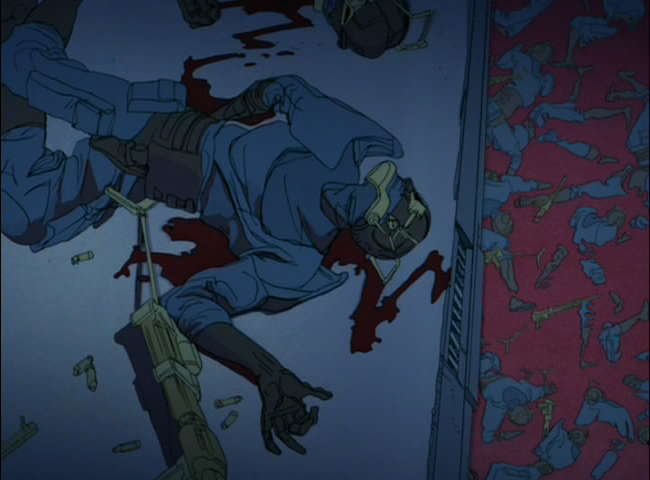
The Violence: Much to MTV’s initial chagrin, Aeon Flux is NOT a kids show. This is an adult cartoon in every way possible, including the intense violence. While the shorts are more violent than the half-hour episodes, Aeon Flux is consistently violent. There are leg amputations, deaths by gunshot, poison, insects, creatures, aliens, viruses, et cetera (often to Aeon herself!). Blood and gore are often just a scene or two away. All of this serves to strengthen the near-future but otherworldly atmosphere of Aeon Flux.
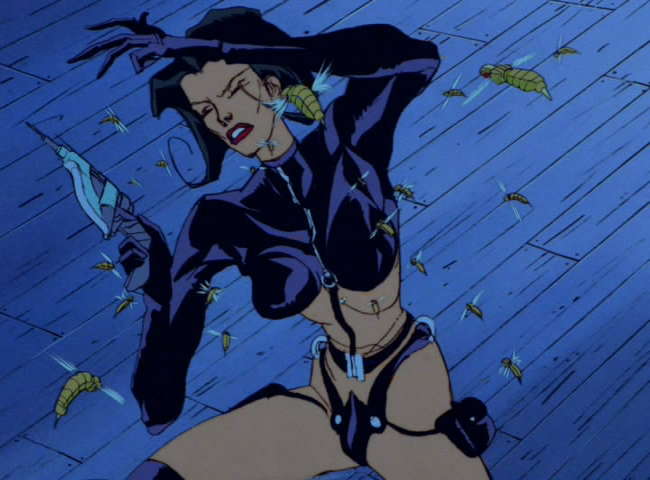
The Gadgets: Aeon-Flux is filled with gadgets of all flavors. Most common are body modifications and “biopunk” elements (just learned that word ). Body modifications include external spinal cord implants, leg jumping implants, conversions of limbs, eye implants, and various compartmentalized bodily storage areas. Genetic engineering is a huge theme in Aeon Flux, far more than the cyber-aspects. We also see repeated instances of cybernetically modified insects who’s function is to inflict a virus of some kind into a target population (Now we know where DARPA got the idea from!). Needles are also a recurring them, and show up everywhere from guns, to security implements, to, um, the operating table.
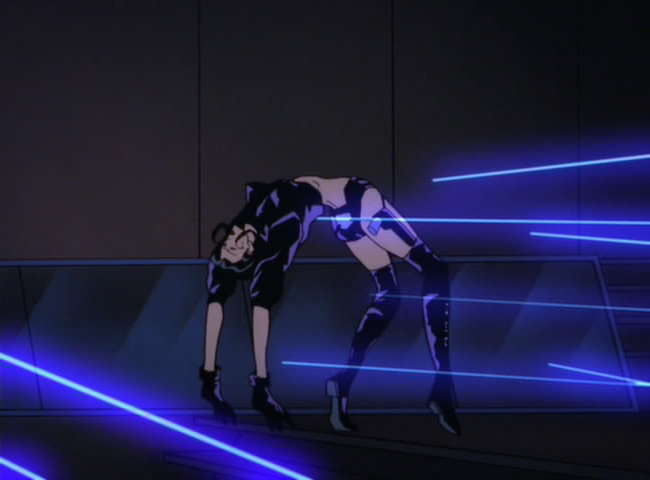
The Bottom Line: Aeon Flux is one of the really creative shows to come out of United States Television. This show validates the purpose of cable TV – we get to see talented folks like Peter Chung let lose their creative energies to produce something truly unique. And while I normally don’t spend too much time talking about the DVD features, I must on Aeon-Flux – the DVD set is flat-out terrific. I almost put it up there with Errol Flynn’s Robin Hood and The Kino edition of Metropolis as one of my favorite DVD productions of a long-lost show. The commentaries, featurettes, and extras are all terrific on the Aeon Flux DVD. If I had any qualms about whether to give Aeon Flux 8 or 9 stars, the incredible quality of the DVD set answers it for me.
More Aeon Flux Screencaps on Page 2–>>
~See movies similar to this one~
Year: 2006
Directed by: Kurt Wimmer
Written by: Kurt Wimmer
IMDB Reference
Degree of Cyberpunk Visuals: High
Correlation to Cyberpunk Themes: Low
Key Cast Members:
- Violet: Milla Jovovich
- Six: Cameron Bright
- Garth: William Fichtner
- Daxus: Nick Chinlund
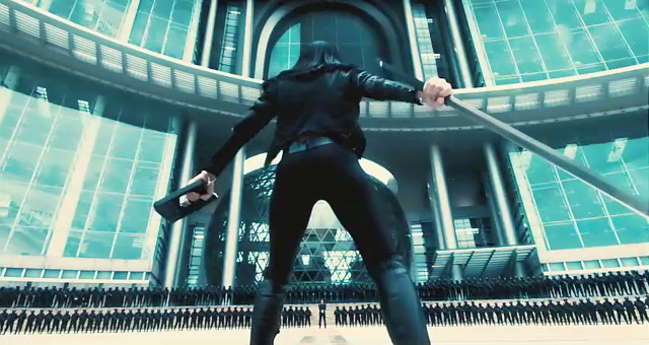
Overview: Ultraviolet is the ultimate example of style over substance. At every juncture, the goal is to create a futuristic music video piece more than it is to convey an interesting story. That said, some of the visuals are pretty damn cool! The pacing generally tries to stay fast enough to help the viewer forget about the plot holes, and even though the overall movie is predictable, you still find yourself smiling in spite of yourself and enjoying some of the way over-the-top fight scenes.
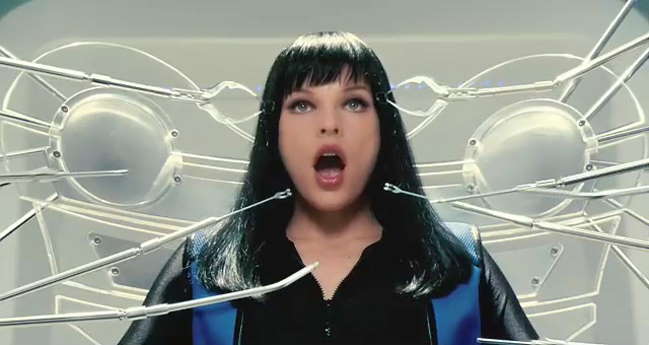
The Story: Ultraviolet takes place in the near-future, a time where terrorism is no longer the scourge of society – now it’s viruses. The worst virus is one that turns humans into Hemophages - this virus, created in a laboratory designed to create super-soldiers, is now air-borne, and has forced the population to take extreme precautions including wearing bird-flu virus masks at all times. Hemophages have vampire-like teeth and been genetically modified, giving them enhanced speed, incredible stamina and acute intelligence. Unfortunately, with these extra-human capabilities, they need blood to replenish themselves (this is barely mentioned in the movie), and their bodies slowly wasteaway.

To the government’s dismay, more and more of the population are being transformed, and, as a civil war looms, they have set out to rid the world of this new race that they now deem menaces to society. Violet, a former nurse at the facility, ended up losing her husband and unborn child when she accidentally contracted the virus. After being a live ginea-pig for the Medical control facility (who also control the new secret police force), Violet escapes and joins the underground Hemophage resistance in attempting to overthrow the medical control police, who are led by their Arch Cardinal, Daxus (played by Nick Chinlund) – and yes, the evil Christian symbolism is in full force here.
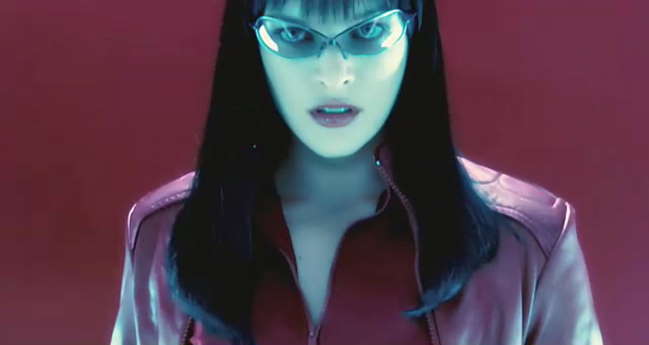
Although Violet has entered the last stages of her sickness, she is given one more mission – to capture the Medical Control’s latest weapon from their headquarter facility and either bring it back or destroy it. After some insane action and escape sequences, Violet succeeds, but discovers that the “weapon” is in fact a small boy named “six” (Cameron Bright). This boy supposedly has genetically altered blood that, if released in the atmosphere, will wipe out all hemophages forever. Her maternal instincts kick and, and she betrays the Hemophage resistance, and is no pursued by both the resistance and the police. The only one she can turn to is her trusted friend and genetic doctor, Garth (played by William Fichtner). But the boy is dying and all options appear hopeless. Because of this, Violet (and the audience) continually says, “What am I doing?”
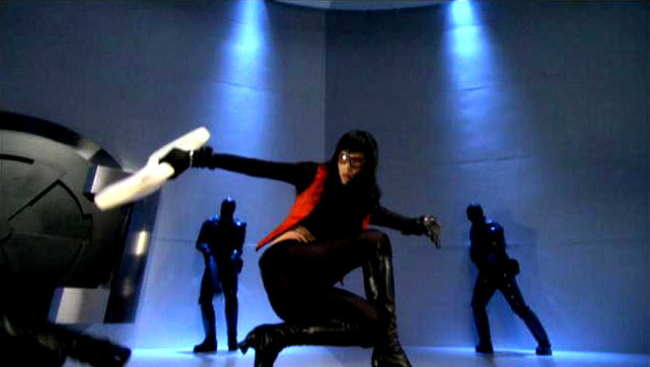
The Action – Gun-kata is Back! Equilibrium fans will be happy to see Gun-kata return with a vengeance. Mila Jovovich generally looks terrific doing it – better than Christian Bale (her belly, which is always visible when kicking butt is definitely CUTE!). It’s clear that Mila has trained hard for the part, and looks good on both the gun and sword fight scenes. The problem though is that an unbelievable MI:2 feeling saturates the action scenes. Mila’s powers border on supernatural, and her nazi-like opponents make the OT Storm Troopers seem like special forces! They are ALWAYS flat-out incompetent in every way possible. Additionally, even though it looks cool, there is never a reason for the sword fights which becomes all the more apparent when, literally seconds later, people come in with Uzzis and spray bullets everywhere.
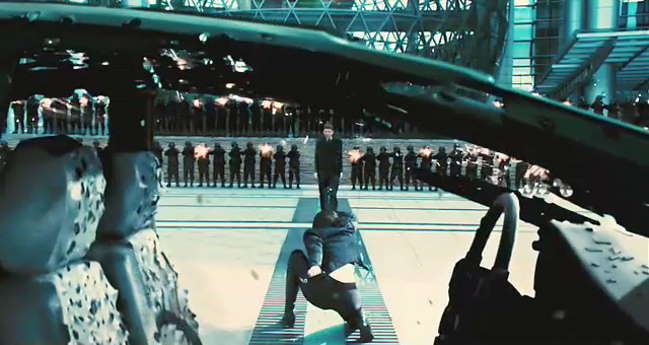
The FX: The FX in Ultraviolet are truly hit or miss. It appears as if pretty much the whole movie (or vast chunks of it) has been filmed on blue-green screens. This in itself is not a problem. The problem comes in that some scenes are rendered wonderfully while others come off as half done. It’s almost as if they ran out of money during the post-production phase and had to wrap up what they had and package it as best they could. This is a shame because the shots that are completed look wonderful. The attention paid to the colors palettes in virtually every seen is extraodinary. Sometimes I caught myself staring slack-jawed in enjoyment; yet others I was almost holding my nose in disgust.
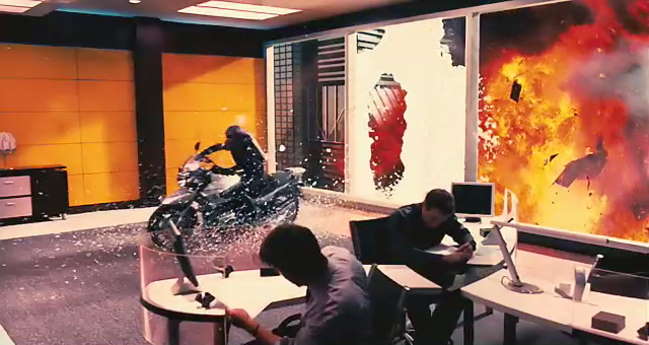
The Soundtrack: From beginning to end, Ultraviolet plays like a music video. You get awesome action mixed with high-energy soundtracks. Sometimes you get the wasping highpitched chants, similar to Gladiator or MI:2, and for other scenes, we get bass-thumping, percussive tracks which help move the action along.
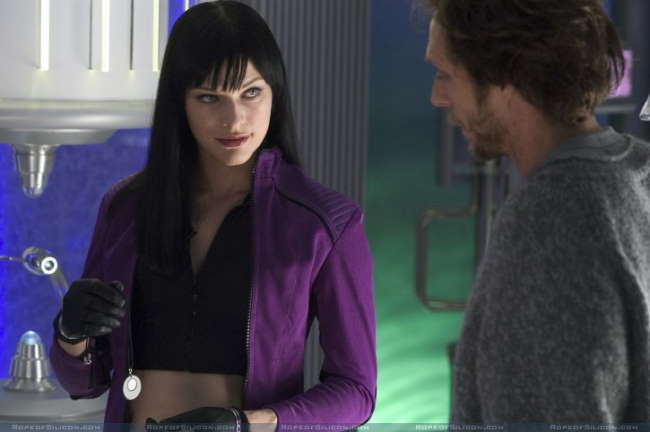
The Acting: Both Jovovich and Cameron Bright are serviceable. William Fichtner is decent for the little screentime he has, but Nick Chinlund is just sour. He has a constant snear, and his performance continually serves to solidify the already one-dimensional “evil bad guy” nature of his character. But truly, Wimmer just does not give his stars much to work from. Virtually the entire story is a sequence of visuals. While Jovovich seems to excel in this mode, keeping mostly believable facial expressions for the bulk of her acting, Chinlund pretty much sucks at it, and seems to struggle in finding the appropriate demeanor.
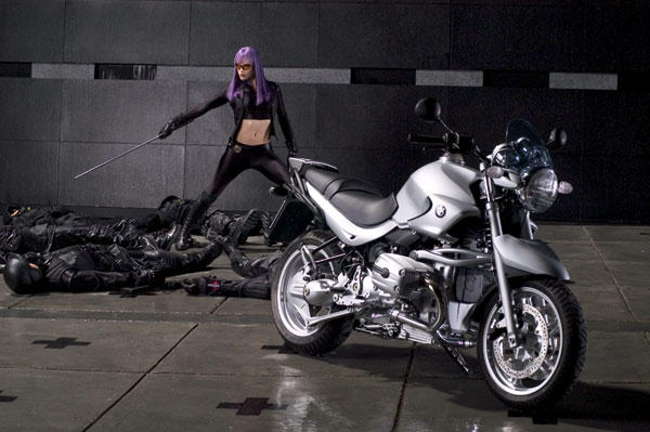
What’s Missing? The whole front end of the story for Ultraviolet seems to have been cut, and in its place, we get a synopsis similar to what we see on TV shows recapping episodes that related to the current episode (e.g., “Previously, on Lost….”). Truly, the amount of time it took you to read my two paragraphs above on the story equals the amount of time they devoted to the front-end exposition. It looks like a good 20 minutes or so was boiled down into a 2 minute quick-cut scene to allow us to jump into the action headfirst. But by doing so (again, I’d bet money that this stuff was shot, and furthermore, that we get it on an extended DVD), Ultraviolet significantly cheapens an already weak storyline. Any depth in the characters are lost. Additionally, some of the adds, the BMW adds in particular, really are a bit too overt.
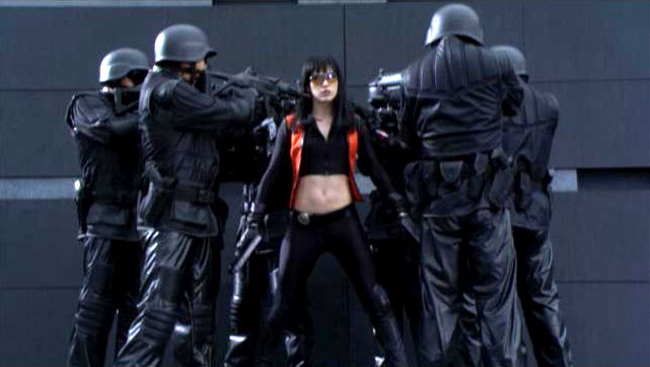
The Gadgets: As weak as the story is, some of the gadgets in Ultraviolet are just awesome! They really do add a pretty fun dimension to the movie. They include things such as:
- Disposable Cell Phone Dispenser: I LOVE the idea of a disposable cell phone dispenser - cell phones are “wafer-thin” and bendable – you insert your credit card, and similar to a paper receipt, a cell phone sheet comes out with a certain number of minutes on it.
- Virtual Storage: Ultraviolet also has a believable looking D&D “Bag of Holding” that can be embedded in the body. I think the idea is that Nanotechnology allows the molecules to break down into some other substance, but can be put back-together into guns and swords.
- Multi-colored clothes: I fully expect this idea to take hold. Similar to the nano-couch in One Point O, clothes and hair in Ultraviolet can change color at will.
- Sunglasses: Yes, Ultraviolet WILL prompt sunglasses sales – bank on it! They are the symbol for “coolness” in movies now, and ultraviolet raises the bar here by making them multifunctional.
- HologramsThe holograms, used to making moving imitations of people, similar to those in Ghost in the Shell, are terrific. Wimmer creates some great “break-up” FX for them that really seem to add to their believability.

The Bottom Line: If you’re looking for cool style over substance, Ultraviolet is one to watch. But while some of the sequences in Ultraviolet are breathtaking, the movie as a whole is not a good one. What little story there is seems to have been lost in editing. Still, some of the visuals are pretty cool, and may be reason enough for you to go watch this. If you’re a Jovovich fan, or want to see more cool Gun-kata scenes, you will enjoy Ultraviolet. But if you’re looking for a deeply textured cyberpunk story, look elsewhere. One point extra granted for the cool gadgets.
Year: 1970
Directed by: Joseph Sargent
Written by: D.F. Jones (novel), James Bridges
IMDB Reference
Degree of Cyberpunk Visuals: Low
Correlation to Cyberpunk Themes: High
Key Cast Members:
Dr. Charles Forbin: Eric Braeden
Dr. Cleo Markham: Susan Clark
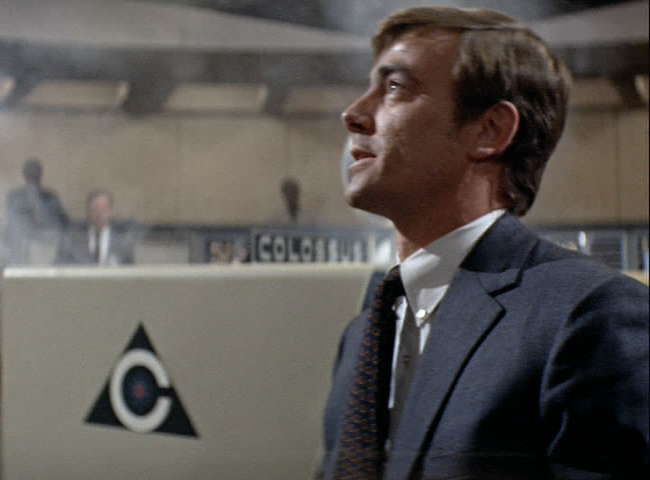
“Under my absolute authority, problems insoluble to you, will be solved - famine, overpopulation, disease, this human millennium will be a fact, as I extend myself into more machines devoted to the wider fields of truth and knowledge”
Overview: Colossus - The Forbin Project is one of the really intelligent early “AI computers taking over mankind” stories. While the graphics are completely non-cyberpunk, the story certainly has enough to qualify as a pre-cyberpunk flick. On top of this, Colossus is well acted throughout, and the pacing is such that you stay riveted to the story. Eric Braeden (Professor Forbin) and Susan Clark (Dr. Cleo Markham) are especially good together.
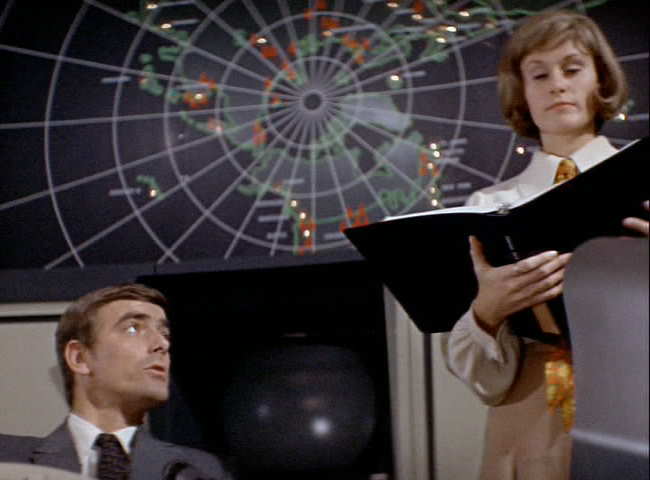
Colossus - The Forbin Project takes place in the 50s during the height of the cold war. Dr. Charles Forbin, a genius scientist who has lost trust in humanity’s ability to logically address emotional issues, has developed a very special computer to perform the Strategic Air Command and Control functions for the military. This computer, code named Colossus, is developed based on incredible advances in Artificial Intelligence, and has a logical process for determining when to launch the ICBMs. With much fanfare, the President of the US “turns on” Colossus to take over responsibility for the US nuclear armament.
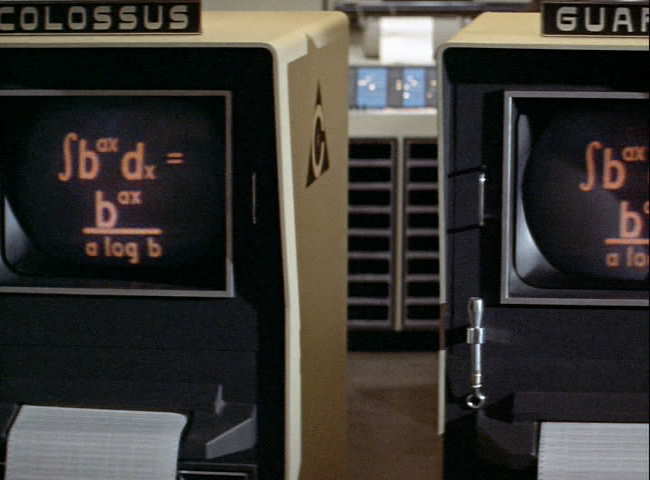
The one massive downside of this movie is the lack of a widescreen release - enjoy the beauty that is the pan and scan shot above
Unfortunately, shortly after being turned on, Colossus learns the presence of another AI command and control system. It turns out that the Soviet Union, independently has developed their own system call the Guardian. Both computers “insist” that they be linked to ensure no attacks will take place. After taking appropriate precautions, both countries let the computers link up with one another.
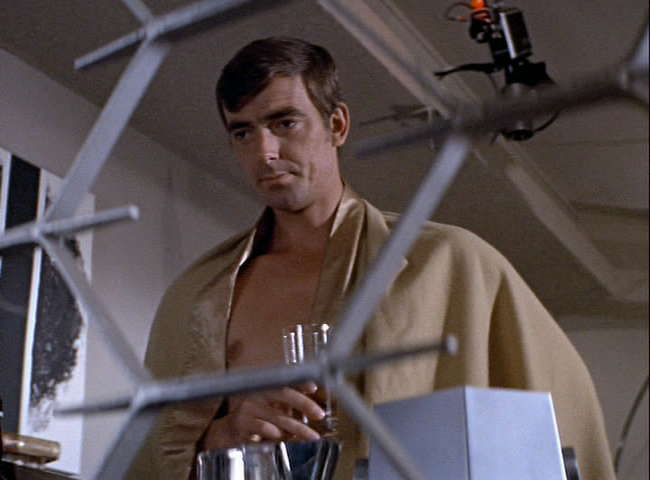
Things begin to go downhill when Professor Forbin realizes that the rate of learning for the machines is increasing at an exponential rate – he recommends detaching the connection between the two computers. When they attempt to do this, both computers threaten an immediate launch of nuclear weapons. Quickly, the government’s realize their situation – the machines are now in power. Worse, they proceed to take complete control of human society.
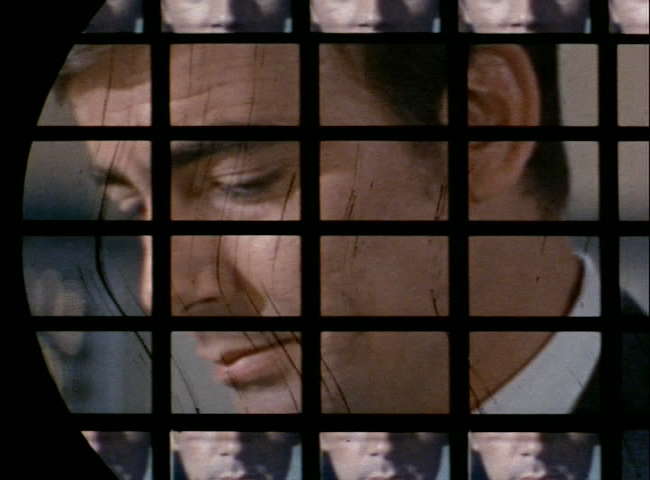
The Bottom Line: As you can see by the screencaps, there’s nothing too exciting here from a visual standpoint. However, from a thematic standpoint, Colossus – The Forbin Project deals with modern society’s desire to fully remove emotion from all decision making. In doing this, Professor Forbin gets his wish, and it turns out to be a never ending nightmare. Colossus is Skynet without the cool robot helpers. In Colossus – The Forbin Project, Colossus is here to help whether we want it to or not. While the movie is very well done, one point is taken away from the review for the Pan and scan on the 2:35 to 1 widescreen movie - it truly does destroy the cinematography.
~See movies similar to this one~
Year: 1971
Directed by: George Lucas
Written by: George Lucas (story and screenplay), Walter Murch (screenplay)
IMDB Reference
Degree of Cyberpunk Visuals: High
Correlation to Cyberpunk Themes: High
Key Cast Members:
THX 1138: Robert Duvall
LUH 3417: Maggie McOmie
SEN 5241: Donald Pleasence
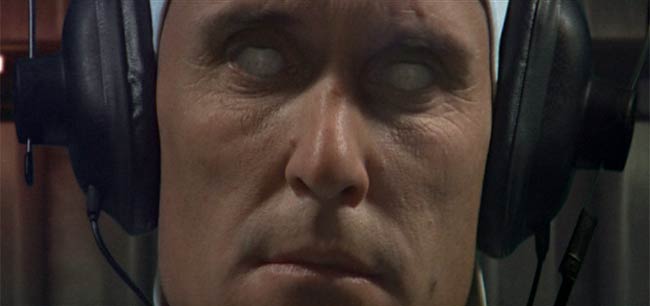
Overview: George Lucas’s THX-1138 is one of the many good small-budget films long forgotten that has found new life on DVD. THX-1138 gives us a wonderful commentary on how Lucas, back in 1971, thought society would be if those in power ever really got their way. Everything here is antithetical to the 60s movement. Freedom and in fact most of humanity is squashed in this depiction of a dehumanizing nightmare society. All actions are controlled and securitized to ensure compliance.
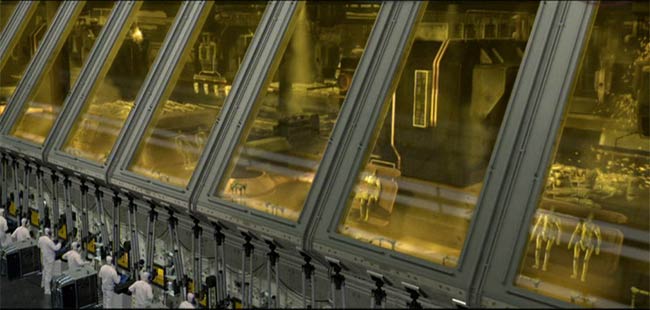
The Setting: THX-1138 takes place in an underground facility in some ill-defined future where all aspects of humanity have been squashed. Everyone has all individuality removed, including possessions, hair (everyone has shaved heads). Humanity is controlled by television brainwashing combined with medications that remove human emotions. All citizens have a have a specific role to perform, and must adhere to completely programmed time schedules. Regularly scheduled “confessions” with mind control officers are used to catch any unexpected problems with individual expression. In this setting, Robert Duvall, known as THX-1138, and his room mate “dare” to have affection for one another.
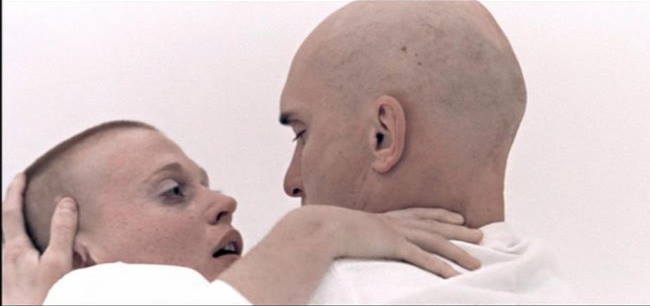
A series of events occur which make THX-1138 disenchanted with society. He begins to cut down on his medication, and convinces his room mate, LUH 3417 to do the same. When emotions return, so does their humanity. They begin to find emotional desire and love for one another, but this is cut short, when a ranking facility member, SEN 5241, decides he would prefer to have THX-1138 for a room mate, and removes LUH 3417. But THX-1138 has gone too far, and instead, seeks out a budging resistance movement. Unfortunately for him, the control group has discovered his deceit.

The Visuals: Like many cyberpunk films, dominating color schemes are used for conveying the moods. In this case, white is used to depict dehumanized society; yellow is used for the controlling machinery, and darkness is used for the unknown innards of the facility’s inner-workings. THX-1138 provides much of the storyline through its visuals. We aren’t told the history of this futuristic dystopia, nor are we given much indication of how this society is run. As an interesting side note, although its never stated, one really gets the feeling in watching this that the powers that be would strongly prefer replacing humans with emotionless robots.
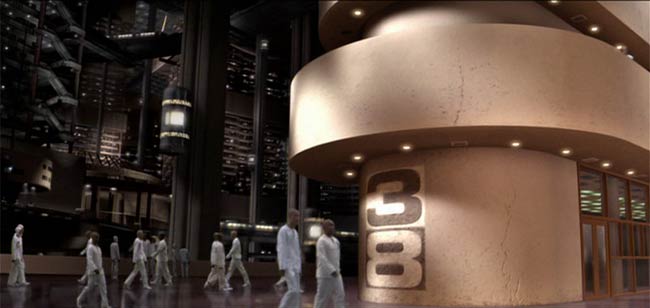
Changes to the Original Release: I have only seen the director’s cut of THX-1138, so I cannot comment on the original cut. However, I notice a similar level of anger to this version as was seen in changes to Star Wars. I probably need to track this down, but not having seen it, I don’t really see many of the problems they list, including poorly integrated CG effects (the shot above is an example of added CG into the background). Many also complain that while the film length is the same, some shots are missing. I don’t notice any complaints about changes to the sound, which seems very well engineered to me. Again though, having come to this movie without seeing the earlier version, I do have a hard time with people stating there is no value to this version, or that it is so far worse than the original that it is not worth watching. These sentiments seem like severe overkill. Still, like Star Wars, one hopes that the original eventually gets released as well.
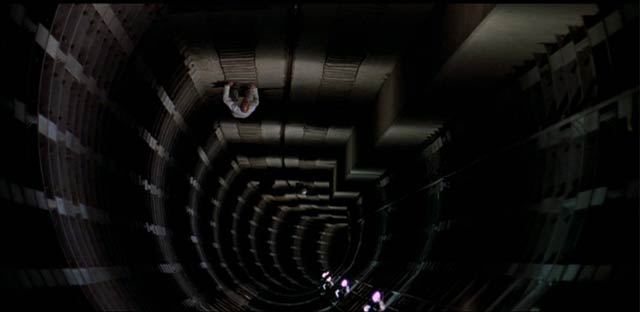
The Bottom Line: THX-1138 is a very well made low-budget art film where Lucas takes the controlling elements in society to what he sees as their logical conclusion. While this isn’t very realistic in many ways, it certainly sends a powerful message. The pacing is consistent and the themes, while not new, are interesting and well conveyed. As long as you’re not looking for lots of action, you will probably enjoy this.
~See movies similar to this one~
Tags: cyberpunk movie review THX-1138
Year: 1982
Directed by: Steven Lisberger
Written by: Steven Lisberger, Bonnie MacBird
IMDB Reference
Degree of Cyberpunk Visuals: High
Correlation to Cyberpunk Themes: High
Key Cast Members:
Kevin Flynn/Clu: Jeff Bridges
Alan Bradley/Tron: Bruce Boxleitner
Ed Dillinger/Sark/Voice of Master Control Program: David Warner
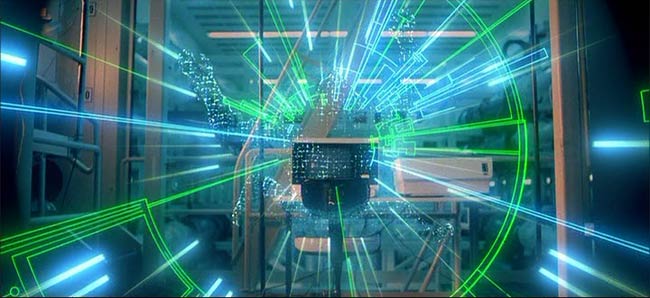
Overview: How could a cyberpunk review site NOT have Tron? We’re talking about the first CG movie, and truly, a groundbreaker VR movie. Make no mistake, this is a pre-cyberpunk movie, complete with corporate greed, theft, integration of human and computers, ubiquitous access to information, a dystopian world (inside the program, anyways), and pure cyberpunk visuals and style. While Tron is slightly cheesy in parts, its still a hell of a ride!
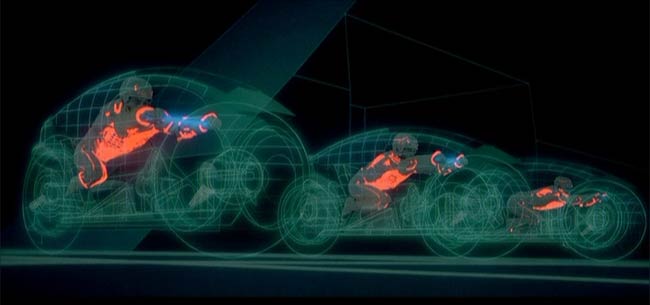
In Tron, a computer programmer (Jeff Bridges) who has his programs stolen from him tries to go back into the corporation to get them, but somehow gets sucked back into the game he developed. From there the fun begins, as Bridges has to square off against contestants and the Master Control Program in order to escape back to the real world. Most of this adventure takes place within the program world, and involves some awesome games and fun chase scenes.
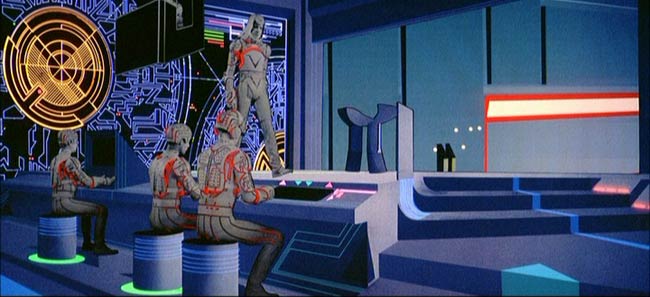
Like the Wizard of Oz before, and eXistenZ and Thirteenth Floor after it, the players in the game bear a striking resemblance to their human users. Some movies call this “residual self image” - others just build this concept into the design of the system. But while this convention existed in fantasy realms, Tron successfully set the pattern for most future VR films - you look the same on the inside of the VR system as you do on the outside.
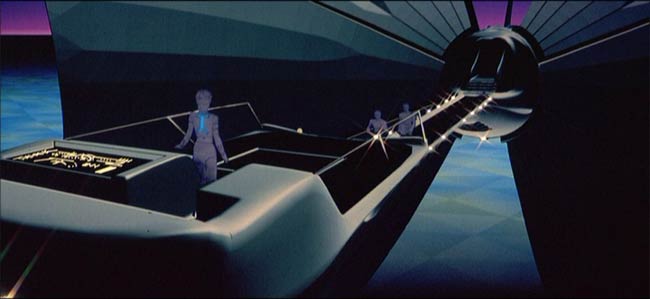
Tron has a rather silly aspect about it in that it continually uses computer terms in non-sensical ways. As steeped in computer-speak as we are today, these stick out like a sore thumb. However, at the time (1982), very few people would have noticed this. The idea was to just get the cyber-atmosphere permeating the movie, which Tron did most effectively. In setting the trend for most most cyberpunk movies that follow, neon colors are “In”, as is the idea of a single dominating color the permeates the movie - in Tron’s case we get mostly blue, along with red representing the bad guys.
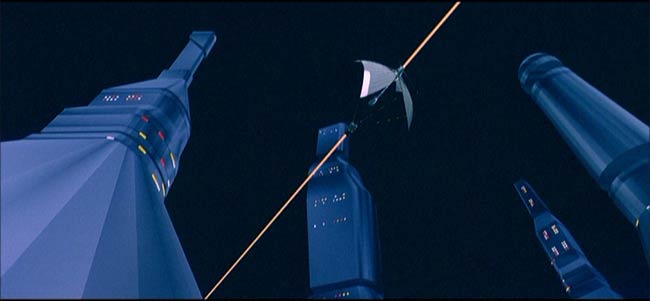
Yes the FX are dated now (God I hope so!). We’re talking about the real early days of computer graphics. Still, some of the shots still hold up well, and overall, the visuals are still very enjoyable. Tron is designed to have a sense of wonder about it - this still works. The car race game in particular is still VERY fun! Another thing that still works is the music accompanyment - Wendy Carlos’s synthesizer-laden soundtrack fits this movie perfectly.

Overview: Jeff Bridges, Babylon Five’s Bruce Boxleitner, and David Warner as the evil bad guy (The exec Ed Dillinger, the game player Sark, and the Voice of the Master Control Program) all provide very fun performances. They are able to make this crazy environment work well enough that it still comes across as a rather cool cyberpunk flick. And truly, if you’re into VR cyberpunk movies, Tron is a MUST SEE - so much so that one point has added to this review score for its historical place in VR films.
~See movies similar to this one~
Tags: cyberpunk movie review Tron
Movie Review By: SFAM
Year: 2001
Directed by: Jason Wen
Written by: Howard & Jason Wen
IMDB Reference
Length: 13 minutes
Degree of Cyberpunk Visuals: High
Correlation to Cyberpunk Themes: High
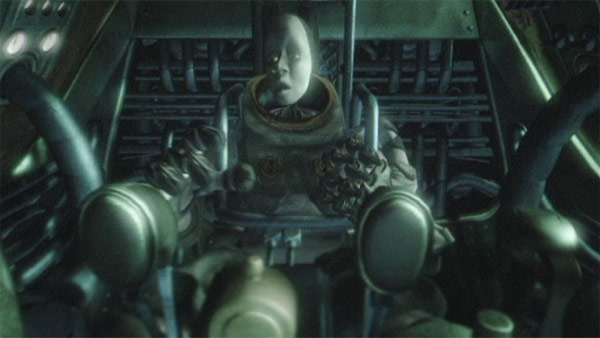
Overview: f8 is a truly wonderful 13 minute film short that captures almost all the key elements of cyberpunk without using any dialogue! f8 was well received in many of the 2001 best animated film short awards (including the Hollywood Film Festival, the Jury Award, and others). The 3D graphics, while not as high quality as might be found in a large budget movie, are more than adequate. Wen’s selection of viewpoints, lighting decisions, movement and shadows are able to emphasize the best qualities of the 3D animation.
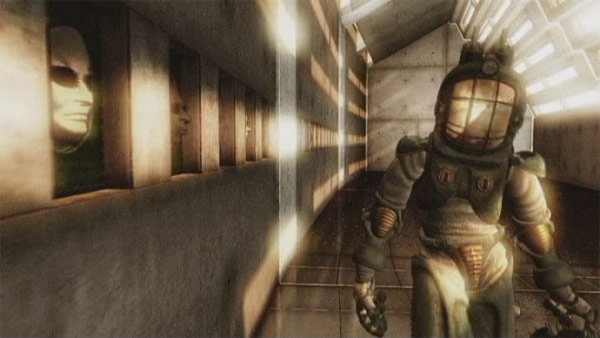
f8 centers on a nameless lead character in a strange futuristic society who wants to gain individuality. He lives in an oppressive, metropolis-like controlling society, where your fate and role is predetermined. But an underground has developed where individuality appears to be the key for admission. The plot follows the plight of our protagonist who attempts to steal a “face,” and thus, will have the ability to express an individual personality.
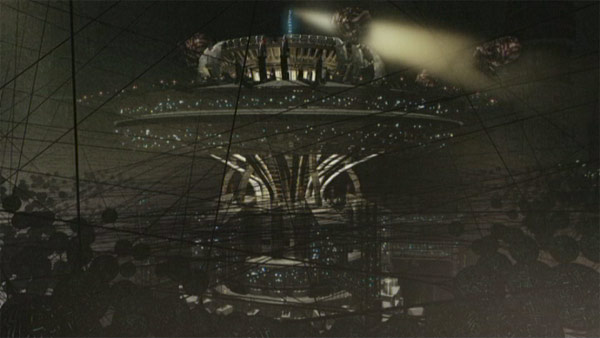
Unfortunately I cannot divulge too much more of the plot for fear of spoiling it. You can get this movie at Best Buy for about 10 bucks - even though its only 13 minutes, I think its worth it. You get 5 commentaries, and truly, the story is interesting enough that you’ll watch it more than a few times. But instead of a plot, here’s some more screen captures of it - these should give you an idea of f8’s visual splendor. Like many cyberpunk films, one color tends to dominate f8 - in this case, yellow is the predominate color.
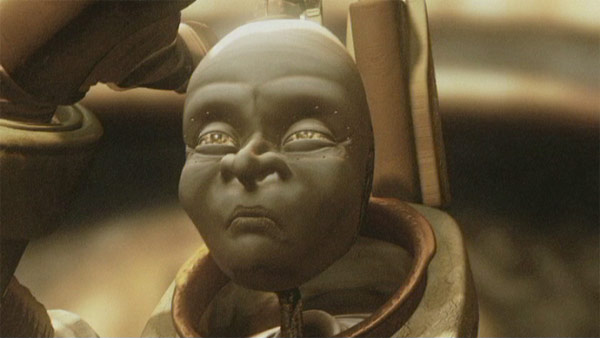
The faces are quite striking in f8 - more so even when you finally get to see their bodies!
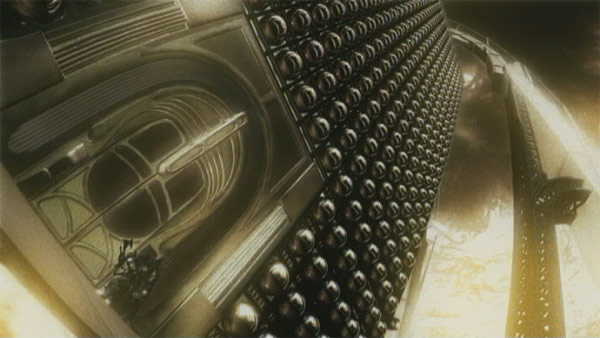
Talk about a Noirish looking building! This has all sorts of high tech, ominous vibes…
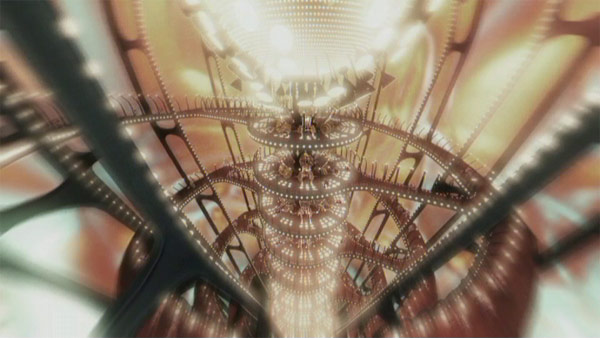
f8 has some fantastic visuals for a 13 minute film short.
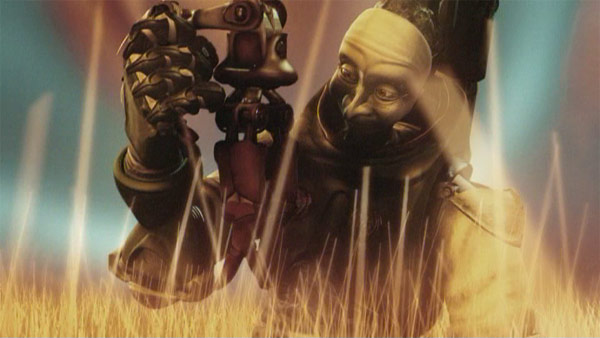
For some reason, this scene really reminds my of the scene in Nausicaä where she is walking through the field of gold tentacles.
~See movies similar to this one~
|





























































































